

Math IEP Goals For Special Education
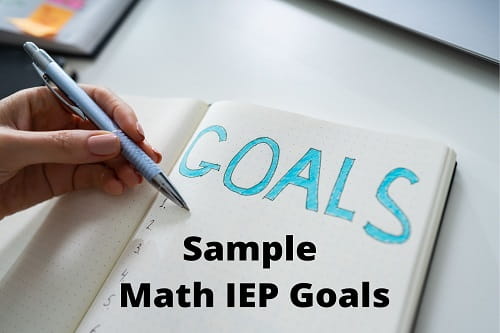
Drafting IEP goals can be difficult, so here are a few math IEP goals (across various ability levels) to get you started. Please adapt and modify to meet the specific needs of your students. Keep in mind a goal should be a skill you believe is achievable by the student in 1 school year. You can always do an addendum if a student has met all criteria for the goal/objectives.
Remember, when writing objectives, break down the goal into smaller steps. You can lessen the percentage of accuracy, the number of trials (3/5 vs 4/5), or amount of prompting. Just make sure the objectives build on each other and are working towards mastery.
The reason why I always list accuracy at 100% when writing Math goals is because the answer is either right or wrong, an answer to a math problem can’t be 50% correct. So feel free to play with the ## of trials for accuracy.
Number Identification:
Goal: Student will independently identify numbers 1-20 (verbally, written, or pointing) with 100% accuracy on 4 out of 5 trials measured quarterly.
Goal: When verbally prompted by teacher to “point to the number _________”, Student will independently select the correct number with 100% accuracy on 4 out of 5 trials measured quarterly.
Goal: Student will independently count in rote order numbers 1-25 with 100% accuracy on 4 out of 5 trials measured quarterly.
Goal: Student will independently count by 2, 3, 5, 10 starting from 0-30 verbally or written, with 100% accuracy on 4 out of 5 trials measured quarterly.
One-to-one Correspondence:
Goal: When given up to 10 objects, Student will independently count and determine how many objects there are (verbally, written, or by pointing to a number) with 100% accuracy on 4 out of 5 trials measured quarterly/monthly.
Goal: When given up to 10 items/objects, Student will independently count and move the items to demonstrate 1:1 correspondence and identify how many there are with 100% accuracy on 4 out of 5 trials measured quarterly.
Goal: Given 10 addition problems, Student will independently add single digit numbers with regrouping with 100% accuracy on 4 out of 5 trials as measured quarterly.
Goal: Student will independently add a single digit number to a double digit number with and without regrouping with 100% accuracy on 4 out of 5 trials measured quarterly.
Goal: Student will independently add double digit numbers to double digit numbers with (or without) regrouping with 100% accuracy on 4 out of 5 trials measured quarterly.
Adding with Number Line:
Goal: Given 10 addition problems and using a number line, Student will independently add single digit numbers with 100% accuracy on 4 out of 5 trials measured quarterly.
Subtraction:
Goal: Student will independently subtract a single digit number form a double digit number with and without regrouping with 100% accuracy on 4 out of 5 trials measured quarterly.
Goal: Given 10 subtraction problems, Student will independently subtract double digit numbers from double digit numbers with and without regrouping with 100% accuracy on 4 out of 5 trials measured quarterly.
Goal: Student will independently subtract money/price amounts from one another with and without regrouping, while carrying the decimal point with 100% accuracy on 4 out of 5 trials as measured quarterly.
Goal: Using a number line, Student will independently subtract numbers (20 or less) with 100% accuracy on 4 out of 5 trials measured quarterly.
Telling Time:
Goal: Student will independently tell time to the half hour on an analog clock (verbally or written) with 100% accuracy on 4 out of 5 trials measured quarterly.
Goal: Student will independently tell time to the hour on an analog clock (verbally or written) with 100% accuracy on 4 out of 5 trials measured quarterly.
Elapsed Time:
Goal: Given a problem with a start time and end time, Student will independently determine how much time has elapsed with 100% accuracy on 4 out of 5 trials measured quarterly.
Goal: Given a problem with a start time and duration of activity/event, Student will independently determine what the end time is with 100% accuracy on 4 out of 5 trials measured quarterly.
Dollar More:
Goal: Using the dollar more strategy, Student will independently identify the next dollar up when given a price amount with 100% accuracy on 4 out of 5 trials measured quarterly.
Goal: Student will independently identify the next dollar amount when given a price, determine how much is needed to make the purchase, and count out the necessary amount (using fake school money) with 100% accuracy on 4 out of 5 trials measured quarterly.
Goal: When given a price, student will identify which number is the dollar amount with 100% accuracy on 4 out of 5 trials measured quarterly.
Money Identification/Counting Money:
Goal: When given a quarter, dime, nickel, and penny, Student will identify the coin and corresponding value with 100% accuracy on 4 out of 5 trials measured quarterly.
Goal: When given a random amount of coins (all of one type), Student will independently count the coins with 100% accuracy on 4 out of 5 trials measured quarterly.
Goal: When given a mix of coins (to include quarter, dime, nickel, penny), Student will independently count the coins with 100% accuracy on 4 out of 5 trials measured quarterly.
Goal: When given a mixture of coins and dollar bills, Student will independently count the money with 100% accuracy on 4 out of 5 trials measured quarterly.
Goal: When give 2, 3, and 4 digit numbers, Student will independently round to the nearest tens, hundreds, thousands independently with 100% accuracy on 4 out of 5 trials measured quarterly.
Greater than/Less than:
Goal: Given 2 numbers, pictures, or groups of items, Student will independently determine which number is greater than/less than/equal by selecting or drawing the appropriate symbol (<,>, =) with 100% accuracy on 4 out of 5 trials measured quarterly.
Goal: Student will independently count objects or pictures of objects and tally the corresponding amount (up to 15) with 100% accuracy on 4 out of 5 trials as measured quarterly.
Goal: Given a number, up to 20, Student will independently tally the corresponding number with 100% accuracy on 4 out of 5 trials measured quarterly.
Goal: Given data and a bar graph template, Student will independently construct a bar graph to display the data and answer 3 questions about the data with 100% accuracy on 4 out of 5 trials measured quarterly.
Goal: Given a line, pie, or bar graph, Student will independently answer questions about each set of data with 100% accuracy on 4 out of 5 trials measured quarterly.
Goal: Given data and a blank graph template, Student will independently construct the graph to display the appropriate data with 100% accuracy on 4 out of 5 trials measured quarterly.
Goal: Student will independently identify the numerator and denominator in a fraction with 100% accuracy on 4 out of 5 trials measured quarterly.
Goal: When given a picture of a shape divided into parts, Student will independently color the correct sections in to represent the fraction given with 100% accuracy on 4 out of 5 trials measured quarterly.
Goal: Student will independently add fractions with like denominators with 100% accuracy on 4 out of 5 trials measured quarterly.
Word Problems:
Goal: Student will independently solve one step addition and subtraction word problems with 100% accuracy on 4 out of 5 trials measured quarterly.
Goal: Student will independently solve two step word problems (mixed addition and subtraction) with 100% accuracy on 4 out of 5 trials measured quarterly.
Goal: Student will independently solve one and two step multiplication world problems with 100% accuracy on 4 out of 5 trials measured quarterly.
Goal: Student will independently read a one or two step word problem, identify which operation is to be used, and solve it with 100% accuracy on 4 out of 5 trials measured quarterly.
Goal: Given a word problem, Student will independently determine which operation is to be used (+,-,x, /) with 100% accuracy on 4 out of 5 trials measured quarterly.
Even/Odd Numbers:
Goal: When given a number, student will independently identify if the number is odd or even (written or verbally), with 100% accuracy on 4 out of 5 trials measured quarterly.
Measurement:
Goal: Given varying lines and objects, Student will independently estimate the length of the object/picture, measure it using a ruler, and identify how long the object/picture is with 100% accuracy on 4 out of 5 trials measured quarterly.
Multiplication:
Goal: Student will independently solve 10 multiplication facts (2, 3, and 5 facts) with 100% accuracy on 4 out of 5 trials measured quarterly.
Goal: Student will independently solve 20 multiplication facts (facts up to 9) with 100% accuracy on 4 out of 5 trials measured quarterly.
Goal: Given a division problem (where the divisor is _____), Student will independently solve it with 100% accuracy on 4 out of 5 trials measured quarterly.
Feel free to use and edit as necessary. It’s up to you how often you want to measure the goals, but remind parents that even if the goal says 5/5 times quarterly, it doesn’t mean you’re only working on it those 5 times. That is just the number of times you’ll take official data. Just make sure it’s a reasonable ## so you have time to take all the data you need. Especially if you have multiple goals/objectives to take data for!
Happy drafting!
Where should we send your
Free lesson plans, success check your email for your free lessons.
We hate SPAM and promise to keep your email address safe.
Want some lesson plans you can immediately use?
Enter your email address below to get 5 free lesson plans now .
- Grades 6-12
- School Leaders
Free Attendance Questions Slideshow ✨
Free IEP Goal Bank With 110+ Goals and Printable Tracking Sheets
All the goals you need, when you need them.
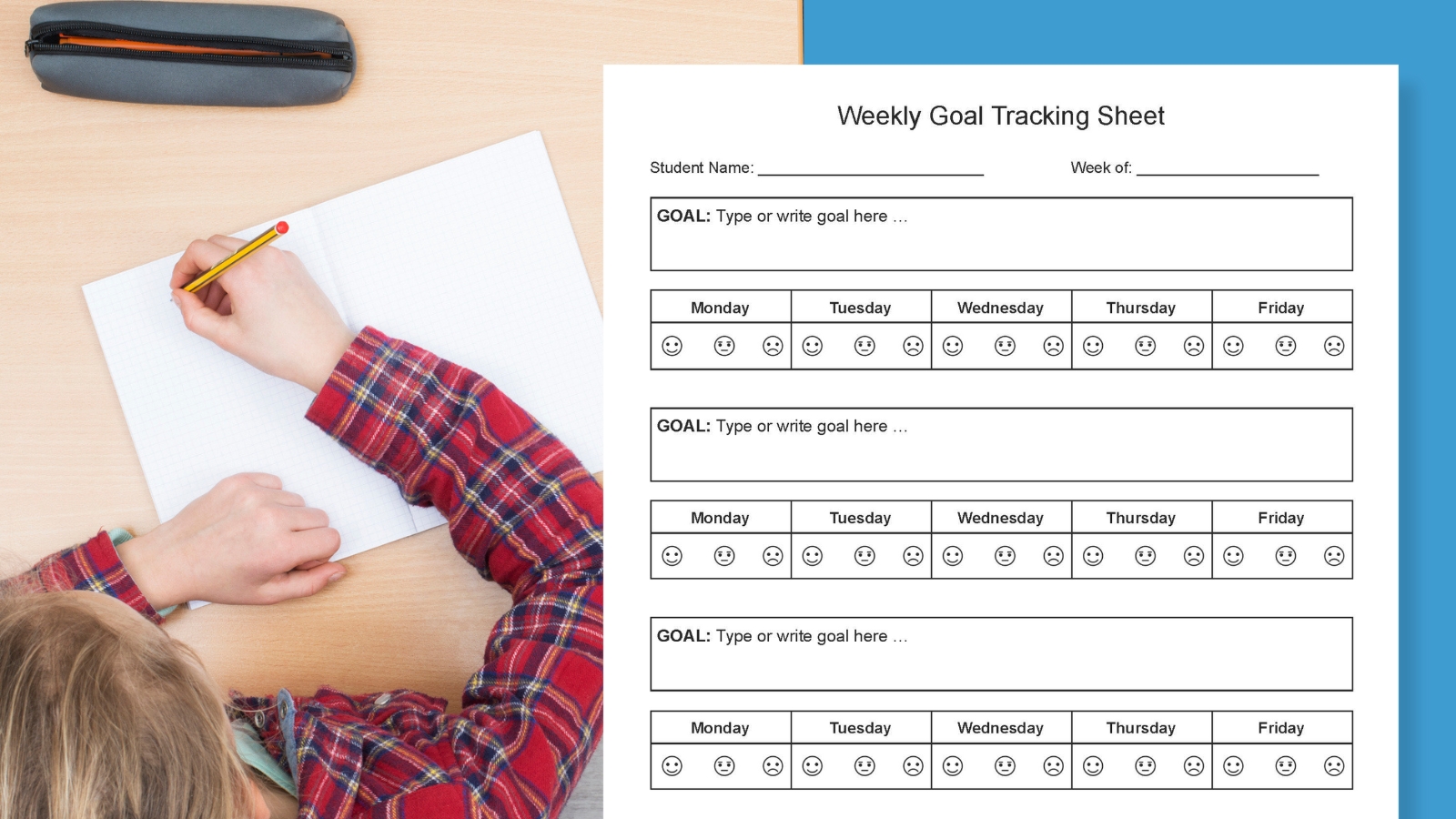
There are as many IEP goals as there are students. But the longer you teach special education, the more you’ll find yourself searching for just the right reading comprehension goal for a student with a learning disability or a behavior goal for a kid who has ADHD. That’s where an IEP goal bank, also known as a goal database, comes in.
Below you’ll find a list of over 100 IEP goals covering a variety of focus areas. Plus be sure to fill out the form on this page to get access to a free, editable Google Doc version of the goal bank along with a bundle of free editable goal-tracking sheets. The bundle includes daily and weekly goal-tracking sheets, as well as trial tracking and progress tracking sheets for data collection.
IEP Goals 101
- Reading Comprehension Goal Bank
- Math Goal Bank
- Writing Goal Bank
- Behavior Goal Bank
- Social Skills Goal Bank
- Social-Emotional Goal Bank
- Executive Functioning Goal Bank
- Self-Advocacy Goal Bank
IEP goals should be specific enough to be implemented by anyone who reads them. They should address aspects of the general curriculum but at the student’s functional level. And the goals should be actionable and measurable.
The goals should also include the accuracy and number of trials that the student needs to complete to show mastery. The accuracy and number of trials will depend on the student’s ability, strengths, and skills. (Typical accuracy and trials are 80% 4-out-of-5 trials.)
Finally, the goals should include the level of support the student needs. Should they be demonstrating the skill independently, or do they need a few prompts or maximum support? Build that into the goal too.
So, a finished goal might be: When given a pile of coins (all one type), Jaime will count the coins and find the total with no more than two prompts with 70% accuracy in 3 out of 5 trials.
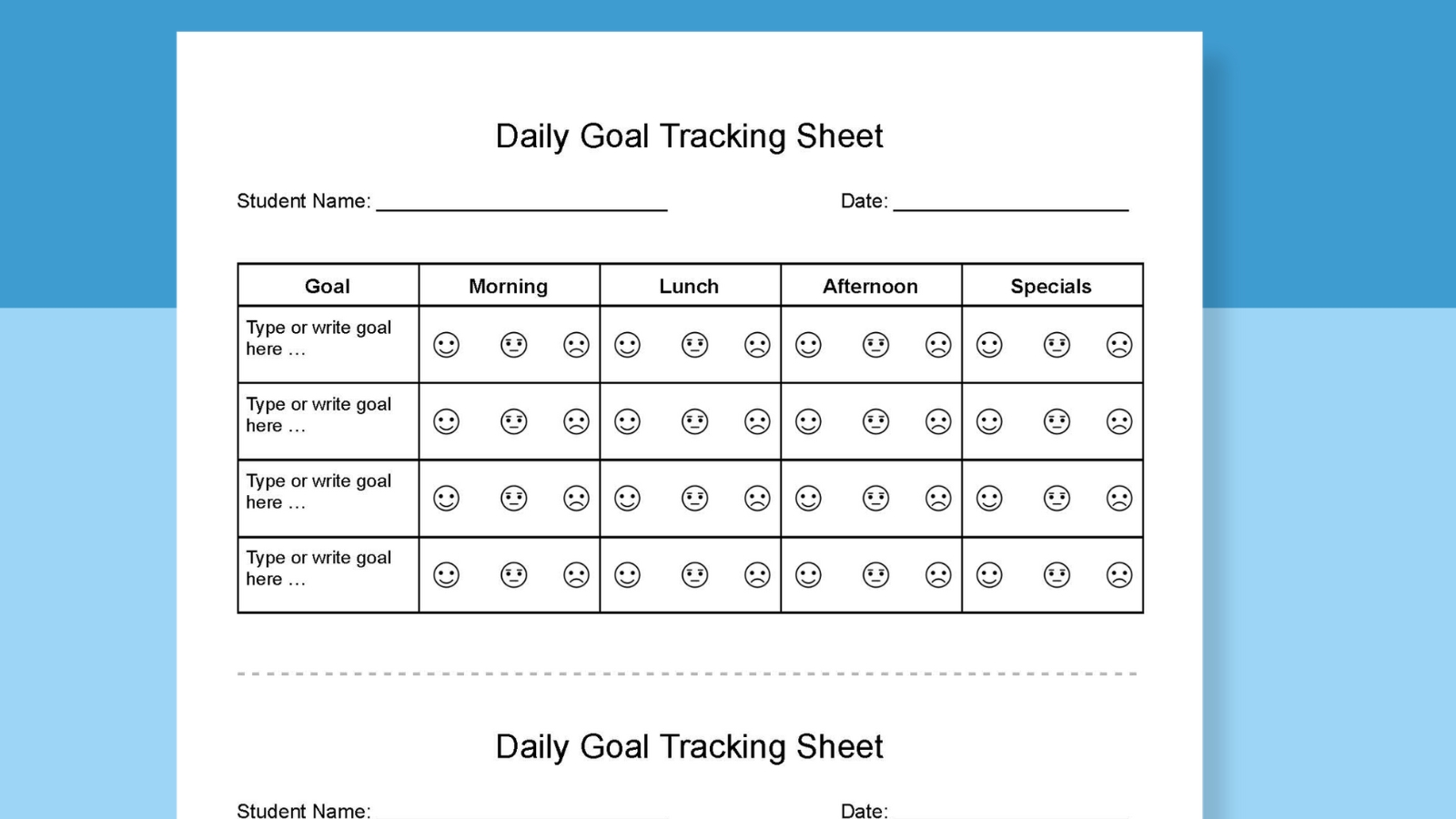
IEP Goals for Your Database
A lot of thought goes into each IEP goal, so here are more than 100 goals that every special education teacher should have in their bank.
Reading Comprehension IEP Goal Bank
Reading comprehension is a skill that many students struggle with it. Choose a goal that helps students reach the next level of reading comprehension so they can understand and enjoy what they read.
- When given a story at their reading level, [STUDENT] will use a storyboard or story map to outline the story’s main elements.
- When given a nonfiction text at their reading level, [STUDENT] will select and use the appropriate graphic organizer to identify key information.
- When given a paragraph at their reading level, [STUDENT] will apply the RAP strategy ( R eading a single paragraph, A sking oneself to define the main idea and supporting details, P utting the information into the reader’s language).

- When given a passage at their reading level, [STUDENT] will use an outline strategy to summarize the content or retell the story.
- When given a text at their reading level, [STUDENT] will read and demonstrate literal knowledge by answering five literal questions.
- [STUDENT] will demonstrate understanding of text using total communication (AAC devices, PECS, verbalization, sign language) to answer five literal questions about the text.
- When presented with a passage at their reading level, [STUDENT] will use context clues to identify the meaning of unknown words.
- When given a passage at their instructional level, [STUDENT] will make a prediction and read to confirm or adjust their prediction with information from the text.
- When given a text at their reading level, [STUDENT] will identify the main idea and two supporting details.

- Given a sentence, [STUDENT] will combine background knowledge with information from the text to infer the author’s meaning.
- Given a passage at their reading level, [STUDENT] will answer five inferential questions.
- After reading a passage with visual supports (e.g., highlighting), [STUDENT] will answer literal questions with minimal assistance.
- After reading a passage at their reading level, [STUDENT] will identify the author’s purpose for writing.
- Given a list of author’s purposes and a text, [STUDENT] will select the correct author’s purpose for writing.
Math IEP Goal Bank
Students may be working on numeracy or word problems. Whatever their focus, choose a math goal that helps them progress.
- [STUDENT] will identify a one- or two-digit number (verbally, pointing, written).
- [STUDENT] will rote-count from 1 to 25 (or higher).
- [STUDENT] will skip-count by 2, 3, 5, 10 to 50 (verbal or written).
![word problem solving iep goals When given up to 10 objects, [STUDENT] will count and state how many objects there are (verbally, pointing).](https://www.weareteachers.com/wp-content/uploads/3-44.jpg)
- Given 10 addition problems, [STUDENT] will independently add single-digit numbers with (or without) regrouping.
- [STUDENT] will independently subtract a single-digit number from a double-digit number with (or without) regrouping.
- Given 10 subtraction problems, [STUDENT] will independently subtract double-digit numbers from double-digit numbers with (or without) regrouping.
- [STUDENT] will independently tell time to the half hour (or quarter hour, etc.) on an analog clock (verbal or written).
- [STUDENT] will independently identify the next dollar amount when given a price, determine how much is needed to make a purchase, and count out the necessary amount using school money.
- Given a quarter, dime, nickel, and penny, [STUDENT] will identify the coin and value.
- Given a random amount of coins (all one type or mixed), [STUDENT] will independently count the coins.

- When given two-digit (or three- or four-digit) numbers, [STUDENT] will round to the nearest tens (or hundreds or thousands).
- Given two numbers (pictures, groups of items), [STUDENT] will determine which number is greater than/less than/equal to by selecting or drawing the appropriate symbol.
- Given data and a graph (bar, pie), [STUDENT] will complete the graph to display the data.
- Given a graph (bar, pie, line), [STUDENT] will answer three questions about the data.
- [STUDENT] will identify the numerator and denominator in a fraction.
- When given a picture of a shape divided into parts, [STUDENT] will color the correct number of sections to represent the fraction given.

- [STUDENT] will solve one-step word problems using addition and subtraction (or multiplication and division).
- [STUDENT] will independently solve 15 multiplication facts (up to 9).
- Given a fact-fluency tracker, [STUDENT] will track mastery of multiplication facts up to 12.
- Given a problem-solving checklist, [STUDENT] will use the checklist to solve a one-step or two-step word problem.
Writing IEP Goal Bank
Here are writing IEP goals for organization, fluency, and editing.
- Given a topic, [STUDENT] will write a sentence that accurately addresses the topic.
- Given a word bank, [STUDENT] will select the appropriate words to complete a sentence or paragraph about a topic.
- [STUDENT] will use a keyword outline to write a paragraph with at least [number of] sentences, including an introduction/topic sentence and conclusion sentence.
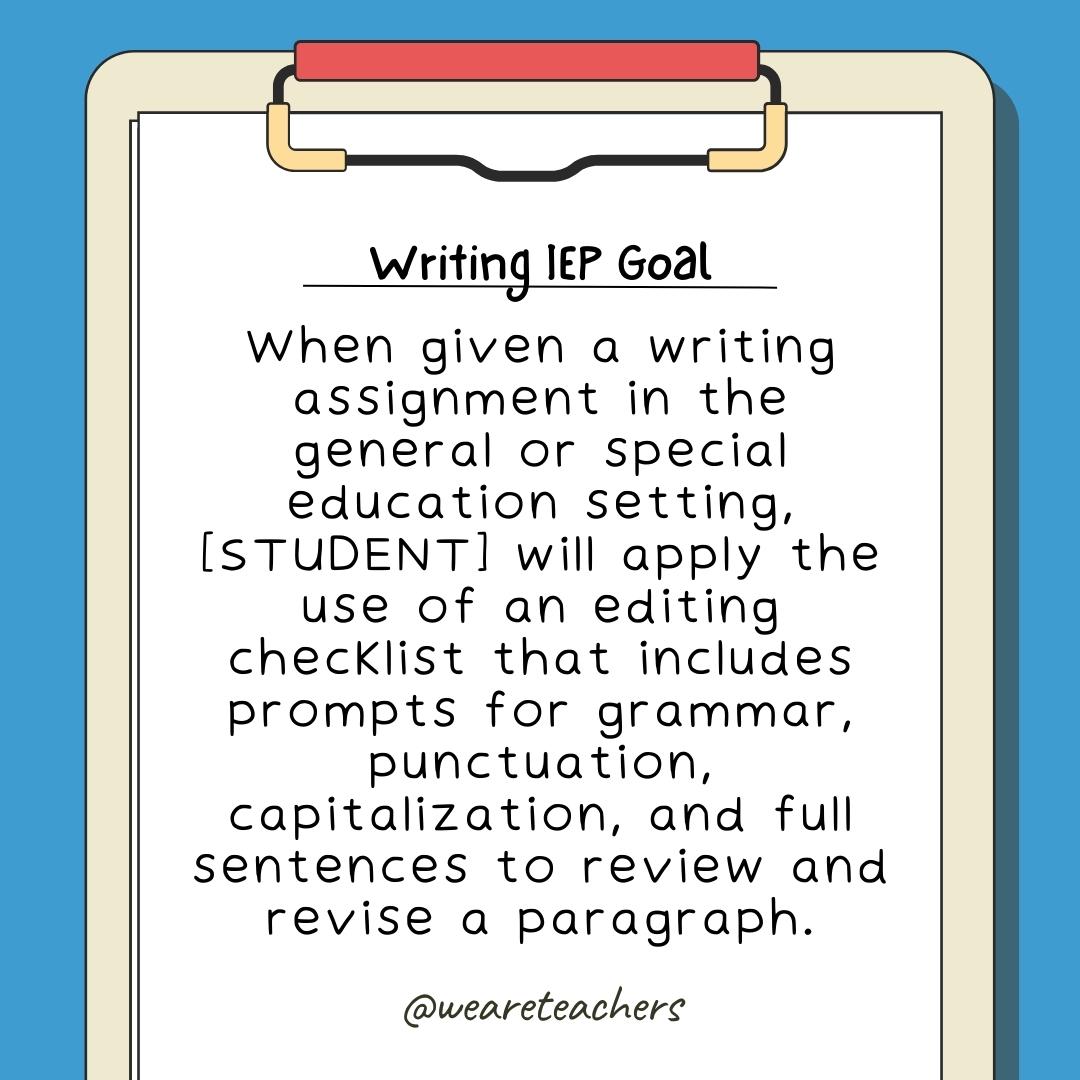
- [STUDENT] will dictate a response to a question and use talk-to-text to communicate at least three sentences about a topic.
- [STUDENT] will write a three-paragraph essay about a topic that includes a clear introductory sentence, main idea, supporting details, and conclusion.
- [STUDENT] will select and use the appropriate graphic organizers to organize ideas in response to a writing topic.
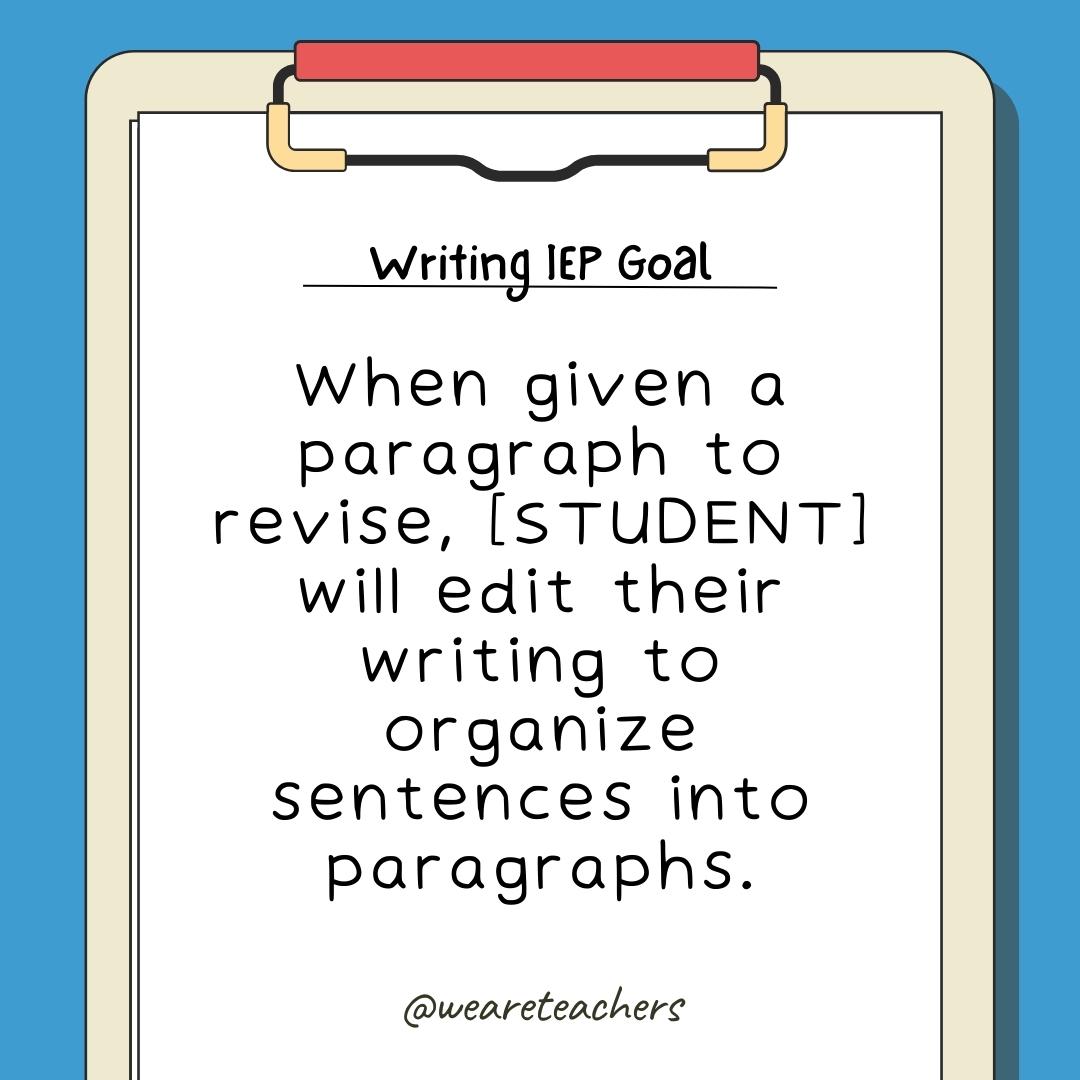
- When given a paragraph to revise, [STUDENT] will add transitional words and phrases to connect ideas in sentences (or paragraphs).
- When given a prompt, [STUDENT] will maintain writing for [amount of time] as measured by observation and student writing output.
Behavior IEP Goal Bank
Everything we see in school is behavior, from working to engaging in class to maintaining self-control and managing emotions. If a student has an IEP for ADHD, an emotional disability, autism, or other categories, they may be working on behavior goals to improve their ability to succeed in school.
- Given a self-monitoring checklist, [STUDENT] will demonstrate self-regulation during [# of sessions] across [# of months].
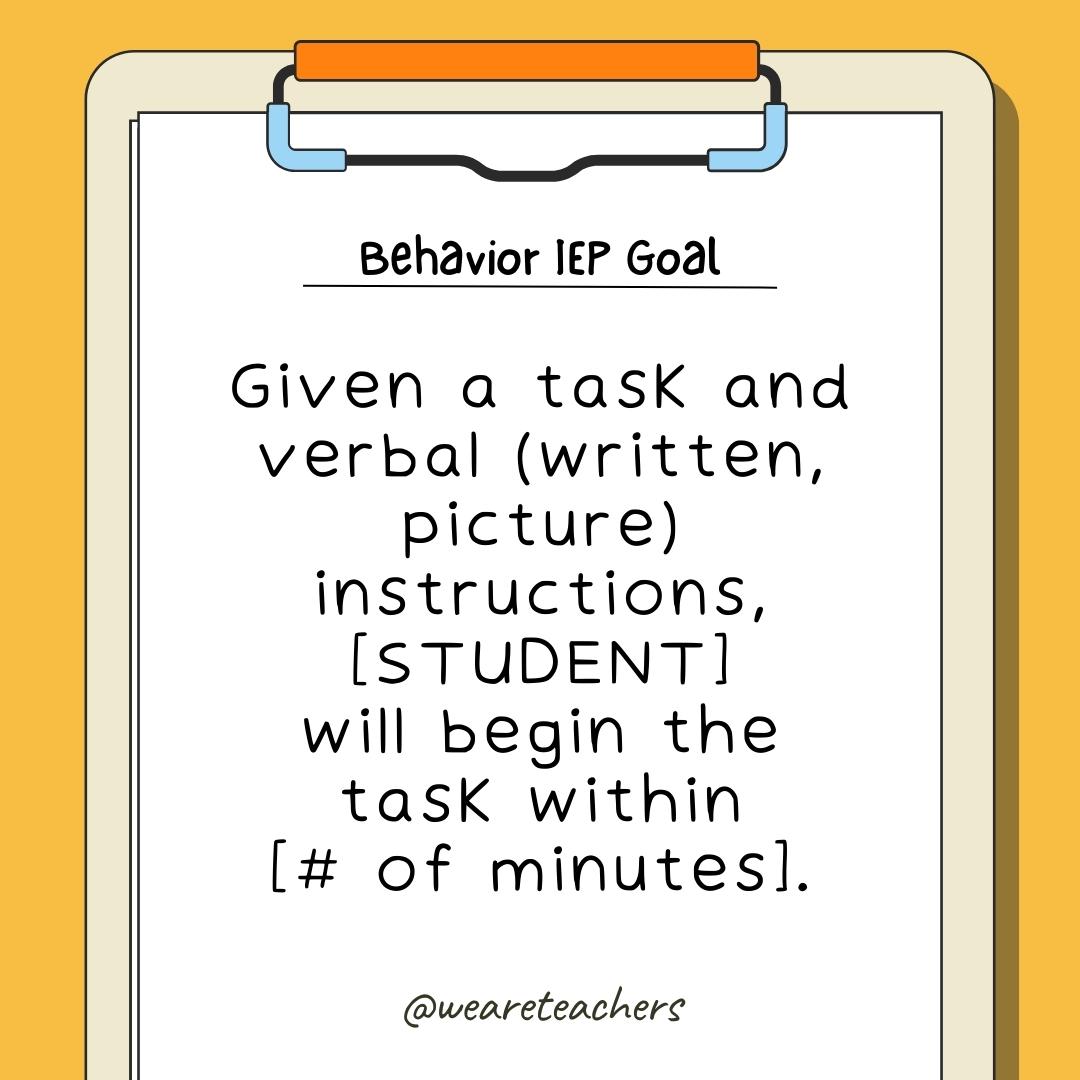
- Given a token board, [STUDENT] will follow class rules to earn [# of tokens] for each 30-minute period in special and general education settings.
- Given a self-regulation strategy (e.g., zones of regulation), [STUDENT] will identify when they are moving from green to red, and apply a self-regulation strategy to maintain their self-regulation.
- Given support and a visual model, [STUDENT] will implement an organizational system for their locker/desk/backpack/binder.
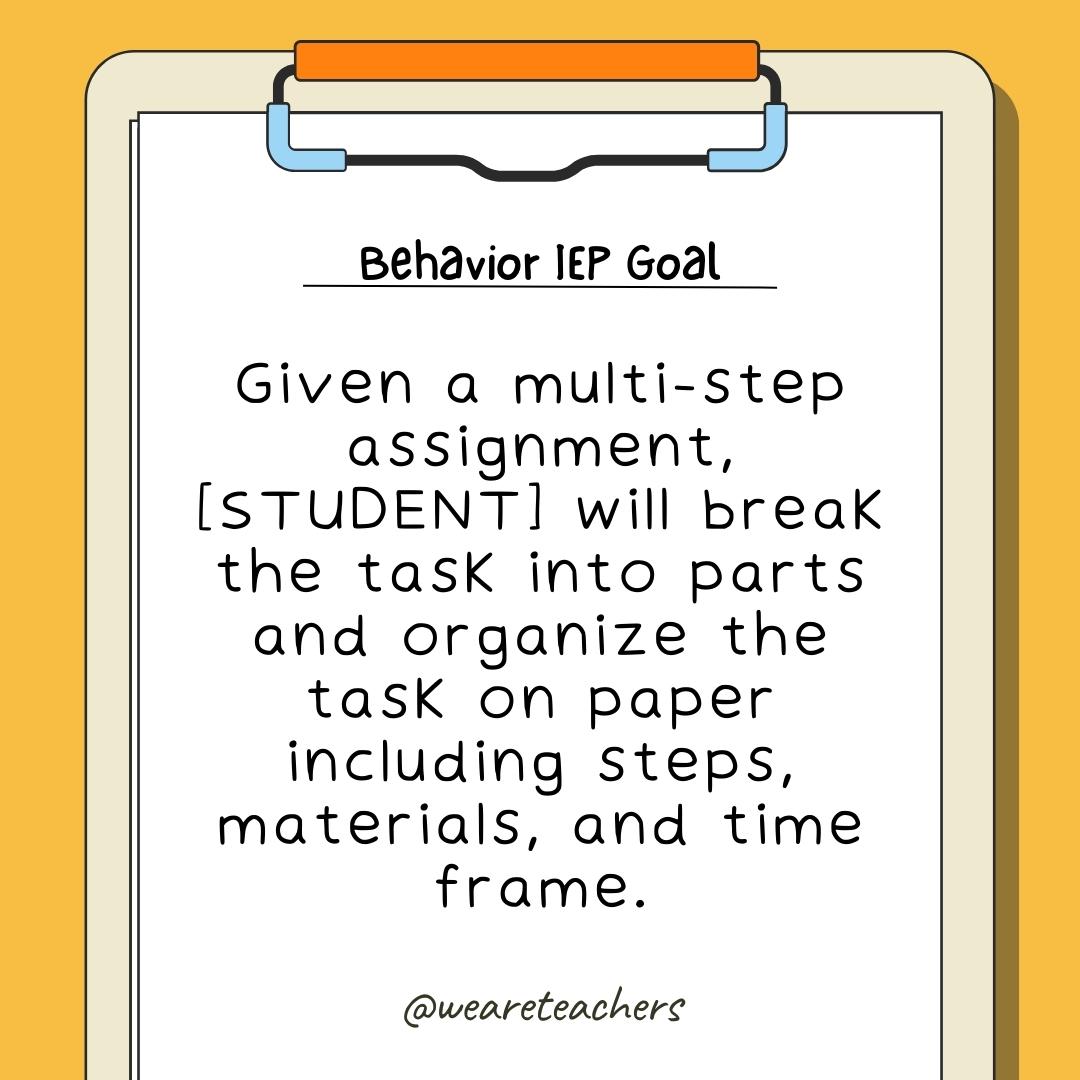
- Given scripts and reminders, [STUDENT] will manage frustration and disruptions to their routine during classroom activities.
- Given a social story, [STUDENT] will be able to adjust to new routines and procedures in the classroom.
- By the end of the IEP, [STUDENT] will manage conflicts, independent of teacher support, 4 out of 5 occurrences over a ___ time period.
- Given a work assignment, [STUDENT] will initiate work tasks as measured by observation and work completion.
- Given a work assignment, [STUDENT] will complete work tasks as measured by observation and work completion.
- Given a token board and visual or rules, [STUDENT] will follow rules and earn tokens throughout the total school environment.
Social Skills IEP Goal Bank
Social skills may not seem academic, but how students engage with others can be an important outcome for students who have deficits in this area. Here are goals that can support their progression in forming relationships with peers and adults.
- During unstructured class time, [STUDENT] will engage in respectful conversation with peers (maintain personal space, use respectful voice).
- During unstructured class time or play time (e.g., recess), [STUDENT] will engage with peers (participate, share, follow rules, take turns) for > 10 minutes with minimal adult prompting.
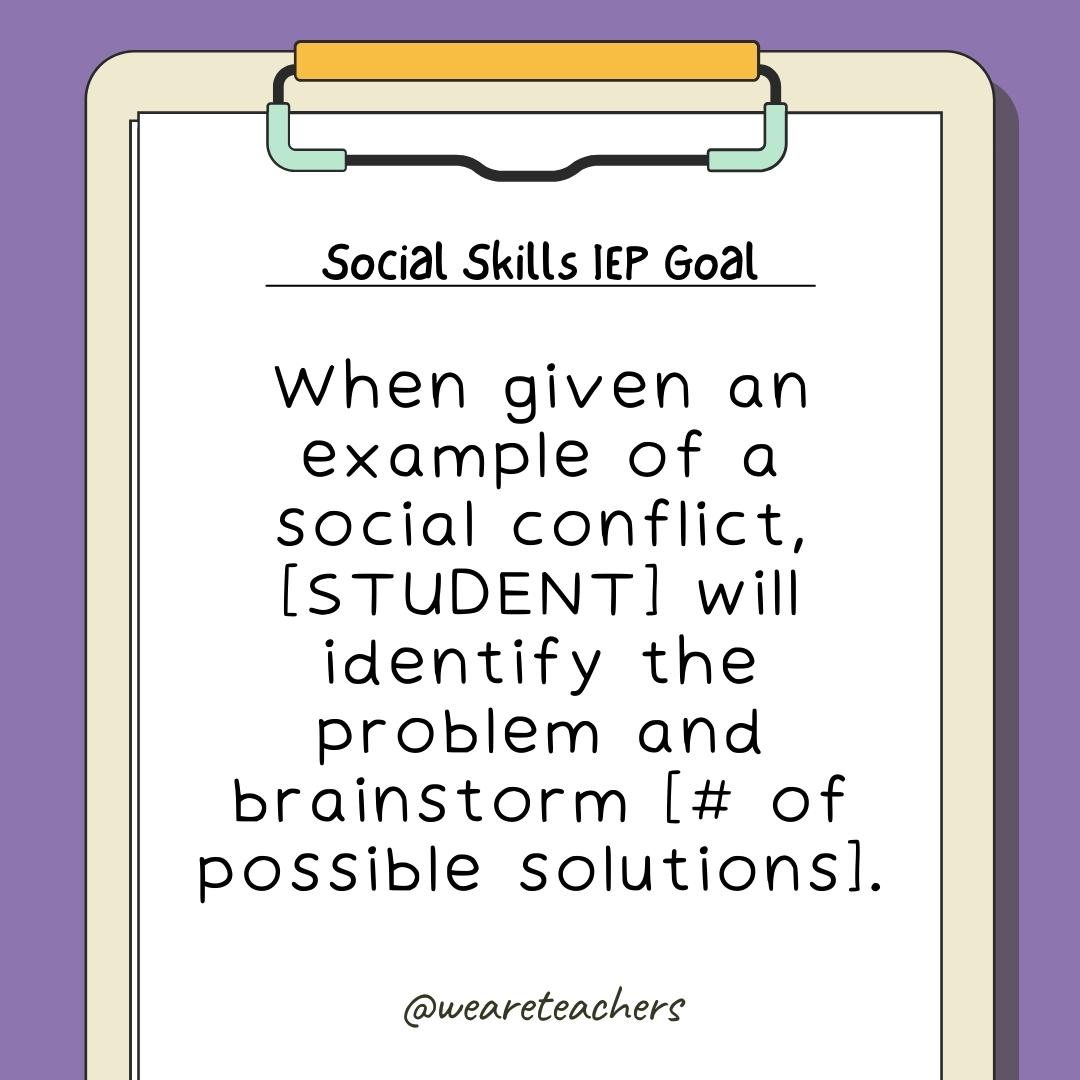
- During a preferred activity, [STUDENT] will invite a peer to join in during recess.
- During a preferred activity, [STUDENT] will engage in appropriate conversation (ask appropriate questions, respond to questions, take turns) for > five turns.
- When frustrated or involved in a conflict, [STUDENT] will resolve the conflict without aggression but will apply a problem-solving strategy (walk away, tell a teacher).
- [STUDENT] will demonstrate five back-and-forth exchanges with peers during structured play activities.
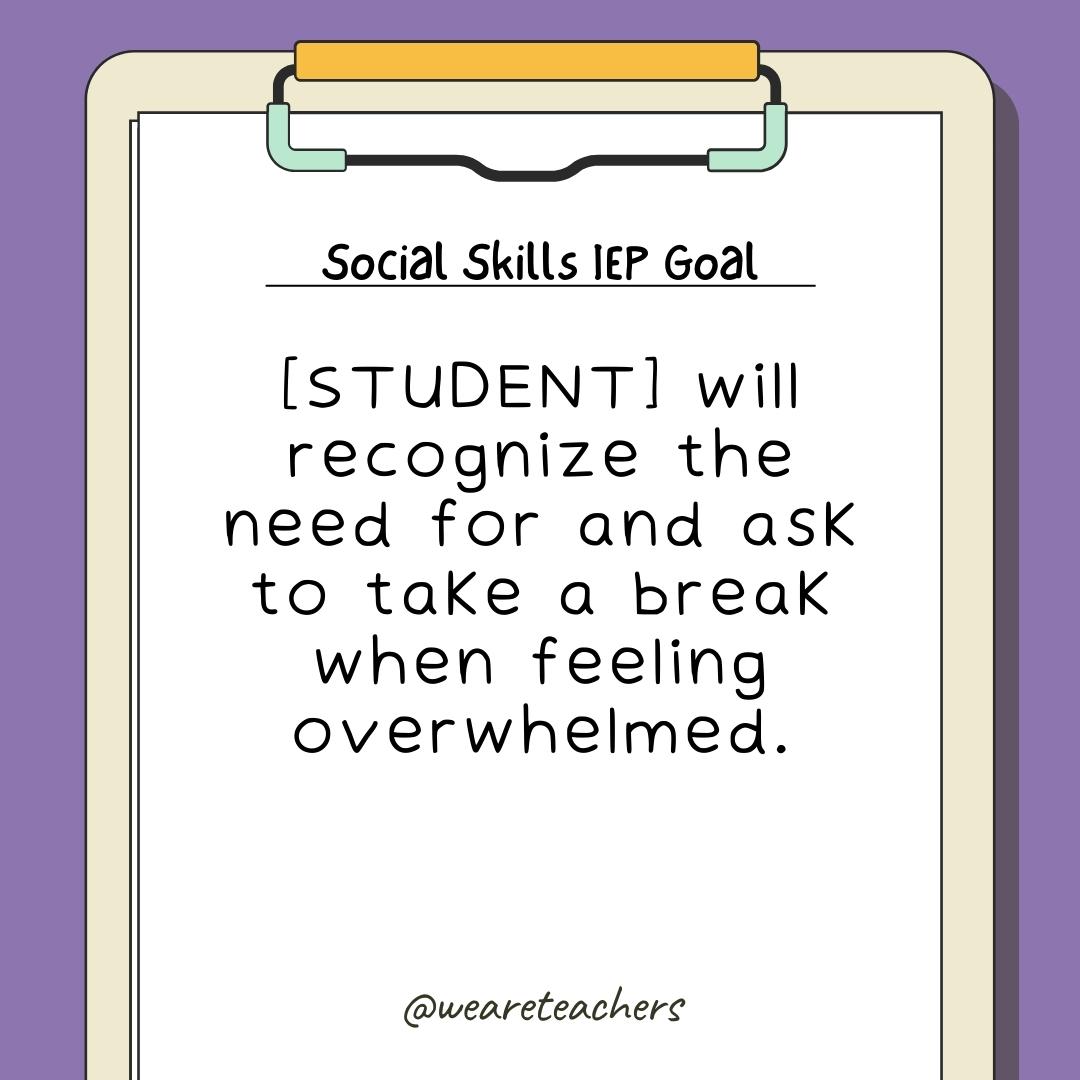
- [STUDENT] will engage in appropriate turn-taking with peers in classroom discussion.
- [STUDENT] will decrease inappropriate verbal comments to once per day (or week) or less as measured by teacher observation and behavior checklist.
- Given a pre-activity checklist, [STUDENT] will identify one peer they would like to engage with and how they are going to engage (e.g., ask a question, invite to play).
Social-Emotional Skills IEP Goal Bank
Identifying and managing feelings is another important school outcome for students who have deficits in this area. Here are goals that help students advance in social-emotional skills.
- [STUDENT] will work cooperatively with peers in small-group settings (e.g., share materials, engage in conversation, accept others’ ideas).
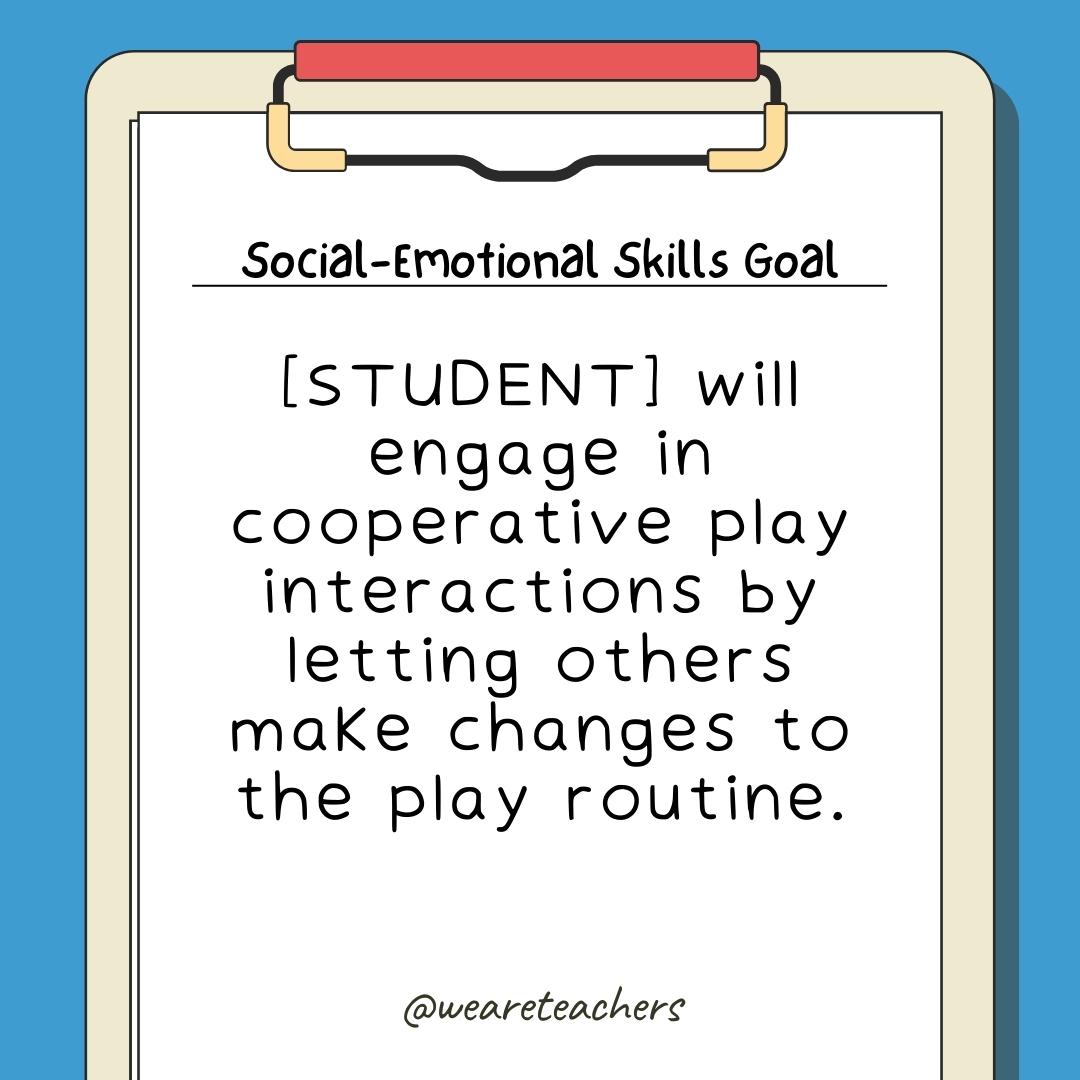
- [STUDENT] will identify appropriate social rules and expectations for various social situations.
- [STUDENT] will refrain from interrupting others.
- [STUDENT] will identify emotions presented in picture form.
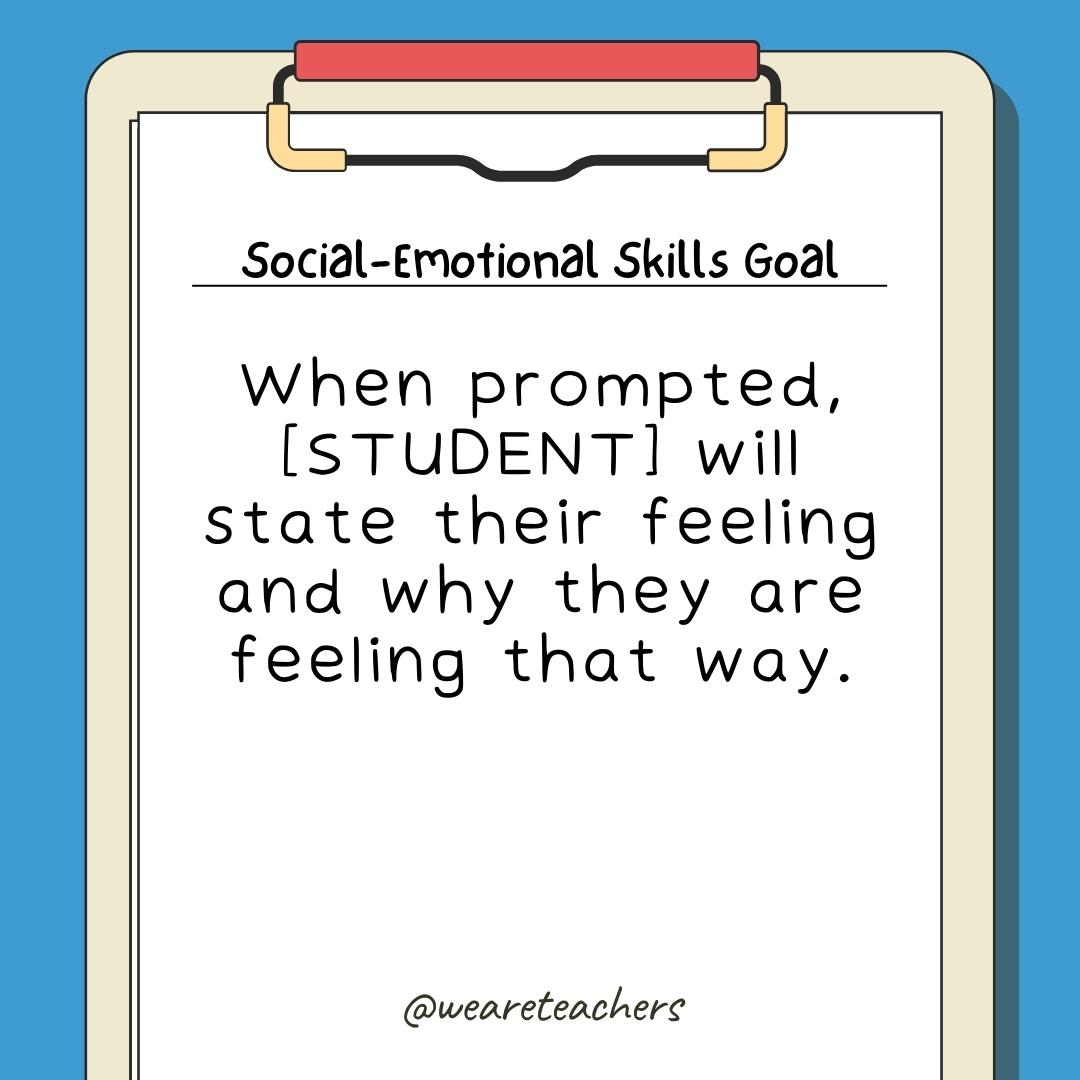
- [STUDENT] will engage in communication with others by asking questions when provided with the opportunities.
- [STUDENT] will increase or maintain conversation about a preferred or nonpreferred topic.
- Given a strategy and visual prompts, [STUDENT] will identify the signs of anxiety and apply a strategy to address feelings of anxiety in real and simulated situations.
- Given a picture scale, [STUDENT] will identify the level of anxiety they are feeling.
Executive Functioning IEP Goal Bank
Executive functioning skills are skills like planning, working memory, attention, problem-solving, mental flexibility, and self-regulation that help kids be successful in school. Students with poor executive functioning have a hard time with time management, organization, getting started with or finishing work, and connecting past experiences with current actions. (Know any kids like this?) Here’s a list of goals for helping students with executive functioning.
- Given visual cues, [STUDENT] will implement a system for organizing their backpack (locker, binder).
- Given a task and a list of materials, [STUDENT] will gather the needed items to complete the task.
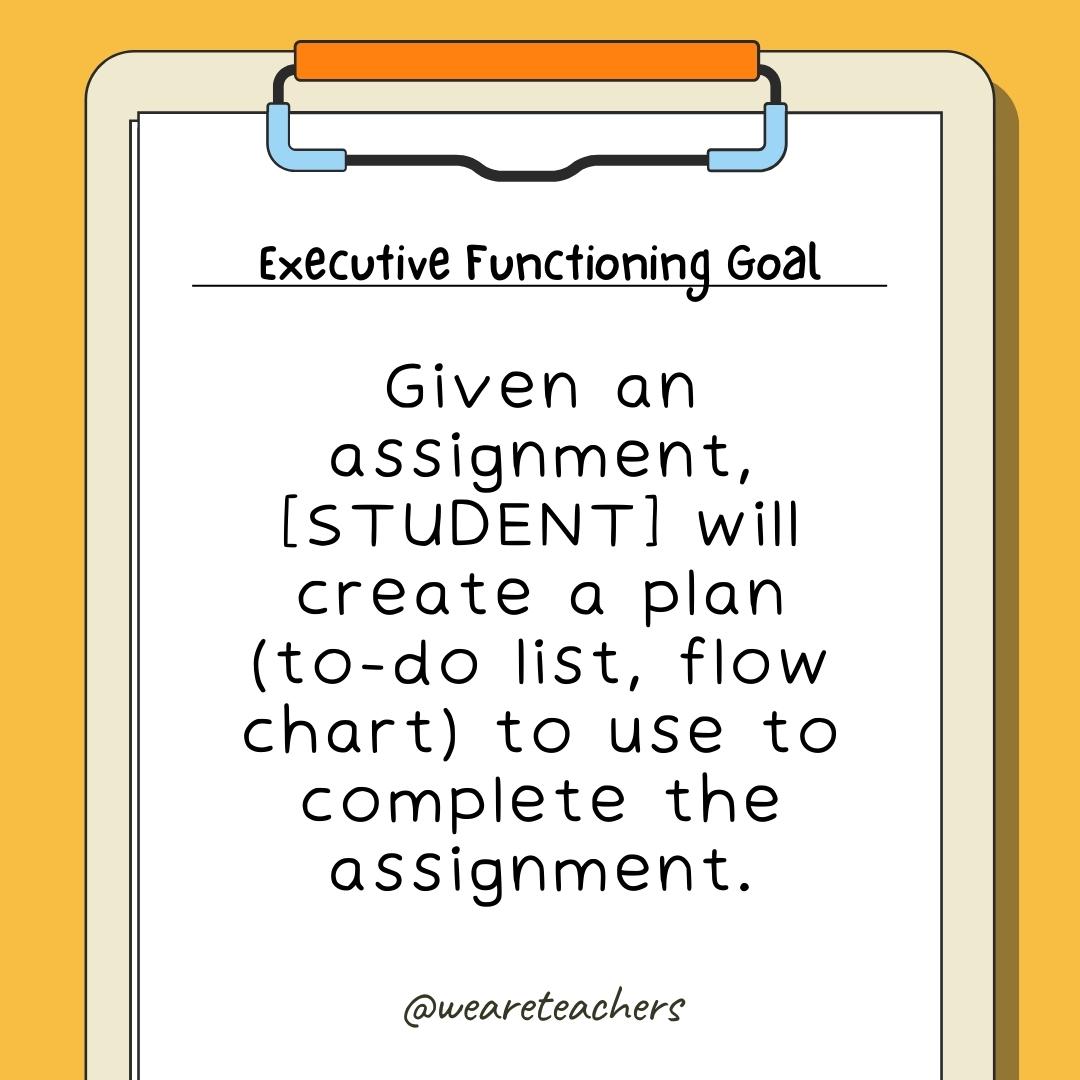
- [STUDENT] will arrive at class with necessary materials (paper, pen, computer).
- [STUDENT] will use a checklist (visual schedule) to independently complete classwork.
- [STUDENT] will respond appropriately to oral commands.
- [STUDENT] will ask for clarification and further explanation when needed.
- [STUDENT] will request desired objects or instructional materials and equipment using [picture prompts, sign language, AAC device, etc.].
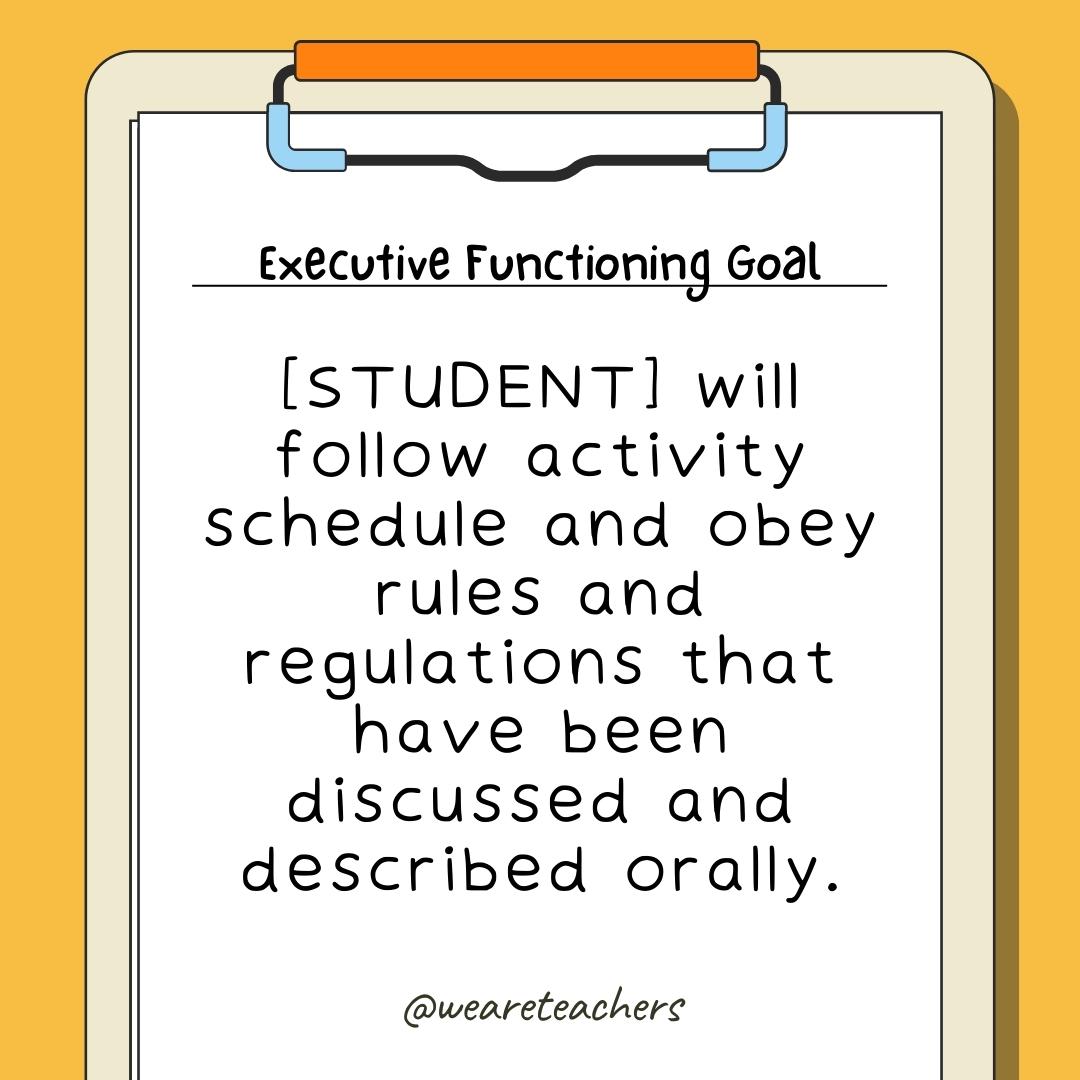
- [STUDENT] will express needs, wants, and feelings using [picture prompts, sign language, verbalization, etc.].
- [STUDENT] will create a daily visual schedule (or checklist or to-do list) and complete it.
- By the end of the IEP, [STUDENT] will demonstrate the ability to follow multiple-step directions (two or three steps) with minimal (one or two) adult prompts.
- By the end of the IEP, [STUDENT] will refer to their checklist for task completion to finish assigned work.
Self-Advocacy IEP Goal Bank
Self-advocacy goals are for skills from decision-making to goal attainment, asking for help, and speaking up for yourself. These are important skills that students need to develop, especially as they transition into independent living, college, and career.
- [STUDENT] will effectively communicate their needs and preferences in the classroom by [raising their hand, writing a note].
- [STUDENT] will use a communication notebook to write questions and concerns to the teacher one time per week.
- [STUDENT] will identify a goal, create a list of steps to achieve the goal, and work through the steps.
- Given a challenging situation to solve, [STUDENT] will define the problem and come up with two possible solutions.
- Given a task that involves a choice (e.g., the school lunch menu, a list of books), [STUDENT] will select between the options available.
![IEP-Goal-Bank-16 Given a task that involves a choice (e.g., the school lunch menu, a list of books), [STUDENT] will select between the options available.](https://www.weareteachers.com/wp-content/uploads/IEP-Goal-Bank-16.jpg)
- [STUDENT] will create a list of three personal strengths and three areas for improvement.
- [STUDENT] will actively participate in the development of their IEP goals and accommodations.
- [STUDENT] will identify one IEP goal and three objectives to support that goal.
- When faced with an academic challenge, [STUDENT] will seek assistance by raising their hand or using the classroom procedure for seeking help.
- [STUDENT] will advocate for accommodations and/or modifications in the classroom using an appropriate time, tone of voice, and language.
- [STUDENT] will demonstrate understanding of their learning preferences using a checklist, verbal communication, or another method of communication.
- [STUDENT] will engage in positive self-talk daily with and without teacher support.
- By the end of the IEP, [STUDENT] will learn and apply two self-advocacy strategies.
![IEP-Goal-Bank-17 By the end of the IEP, [STUDENT] will learn and apply two self-advocacy strategies.](https://www.weareteachers.com/wp-content/uploads/IEP-Goal-Bank-17.jpg)
- By the end of the IEP, [STUDENT] will demonstrate the ability to ask for help when needed.
- By the end of the IEP, [STUDENT] will identify and communicate two environmental requirements (e.g., “I need a movement break”).
- By the end of the IEP, [STUDENT] will engage in three conferences and/or meetings where the student will communicate their educational needs.
- [STUDENT] will explain and advocate for testing accommodations through the classroom teacher, testing center, school counselor, etc.
- [STUDENT] will reflect on their academic progress and will determine which accommodations are supporting their learning.
Get Your Free Editable and Printable IEP Goal Bank and Goal Sheets
Just fill out the form on this page to get instant access to an editable Google Doc with all the goals mentioned above as well as a bundle of four printable and editable goal-tracking sheets. Save your goal bank and access it any time to cut and paste goals into your IEP software and/or into the editable and printable goal-tracking sheets provided. The bundle includes daily and weekly tracking sheets, as well as trial tracking and progress tracking sheets for data collection.
Special education teachers are the best! Here are our favorite TikToks to make you feel seen .
Share your special education stories and connect with other teachers in our we are teachers helpline group on facebook., you might also like.
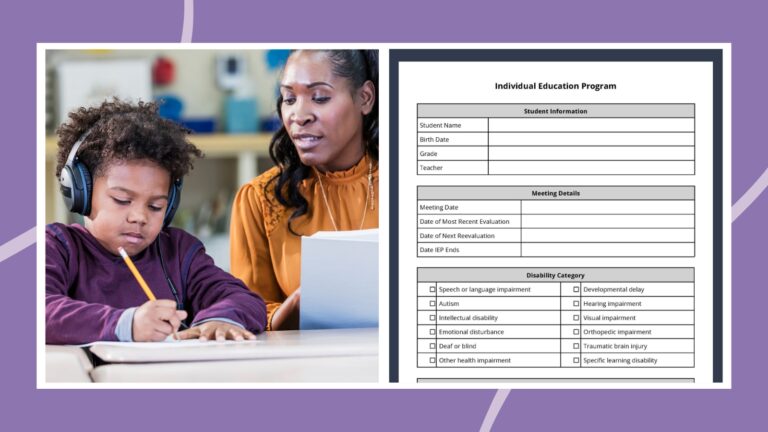
Free IEP Template (Fully Editable and Printable)
Everything you need to write a personalized IEP. Continue Reading
Copyright © 2024. All rights reserved. 5335 Gate Parkway, Jacksonville, FL 32256

IEP Math Goals
Navigating the world of Individualized Education Programs (IEPs) can feel overwhelming, especially when it comes to setting effective math goals for your child. You want to ensure these goals are not only attainable but also tailored to your child’s unique learning needs. Understanding how to create and implement these goals is crucial for fostering academic growth and confidence.
In this article, you’ll discover essential strategies for developing IEP math goals that are specific, measurable, and aligned with your child’s abilities. By focusing on clear objectives and practical steps, you can help your child make meaningful progress in their math skills, setting a strong foundation for future success.
Key Takeaways
- Understanding IEP Math Goals is Crucial: Effective IEP math goals are essential for supporting academic growth tailored to a child’s unique learning needs.
- Core Components of Effective Goals: Goals should be specific, measurable, achievable, relevant, and time-bound to ensure structured and observable progress.
- Key Focus Areas: Concentrate on number sense and operations, problem-solving and reasoning, and measurement and data to build a comprehensive skill set.
- Developing Measurable Targets: Create clear, attainable, and specific targets in accordance with the student’s current skill level and academic requirements.
- Compliance with Standards: Ensure IEP math goals align with state and national educational standards, including regular monitoring, evidence-based practices, and stakeholder collaboration.
- Custom Goals by Education Level: Tailor goals to the child’s educational stage, from elementary to middle school, to address their developmental needs and promote advanced skills.
Understanding IEP Math Goals
IEP math goals are critical for supporting your child’s academic development. Well-crafted goals ensure that the educational plan meets their unique needs and fosters progress in math skills.
Importance of Math Goals in IEPs
Math goals in IEPs drive targeted interventions for your child’s learning needs. They provide a clear roadmap of expected achievements, enhancing motivation and guiding teachers’ instructional strategies. Setting precise goals improves communication between educators and guardians, ensuring everyone’s aligned in supporting the child’s progress. For example, targeting specific areas like basic arithmetic or problem-solving helps measure growth effectively.
Components of Effective Math IEP Goals
Effective math IEP goals are specific and measurable. They should align with your child’s current abilities and potential. Key components include:
- Specificity : Goals should pinpoint exact skills, such as addition or subtraction within 20.
- Measurability : Define how progress will be tracked, like achieving 80% accuracy in solving multiplication problems.
- Achievability : Ensure goals reflect the child’s realistic potential.
- Relevance : Align goals with core curriculum standards and the child’s long-term academic needs.
- Time-bound : Set a clear timeframe, such as achieving a goal by the end of the semester.
By incorporating these elements, you create a structured path for your child’s math skill development, making the progress both observable and attainable.
Creating effective IEP math goals is crucial for helping students achieve measurable progress in their math skills. To develop comprehensive goals, it’s beneficial to include specific performance indicators and ensure the goals are realistic and achievable. For example, setting a goal for a student to improve their proficiency in solving multi-step word problems with 80% accuracy can provide a clear target to work towards ( We Are Teachers ). Additionally, using SMART criteria (Specific, Measurable, Achievable, Relevant, Time-bound) ensures the goals are tailored to the student’s needs and capabilities ( TeachTastic ).
Key Areas of Focus for IEP Math Goals

Setting clear goals in various key areas helps tailor the math curriculum to each child’s needs. These focus areas ensure comprehensive skill development critical for future academic success.
Number Sense and Operations
Your child benefits from strong foundational skills in number sense and operations. Number sense includes understanding quantities and their relationships while operations involve adding, subtracting, multiplying, and dividing. Clear IEP goals in this area might include recognizing numbers 1-100, performing addition up to 20, or understanding the concept of place value. These targets improve mathematical fluency and confidence.
Problem Solving and Reasoning
Developing problem-solving and reasoning skills allows children to tackle real-world math challenges. IEP math goals here might include solving word problems using addition and subtraction, employing strategies to reason logically, and explaining their thought processes. Strengthening problem-solving abilities helps in interpreting and resolving various mathematical scenarios.
Measurement and Data
Measurement and data skills form an essential part of math education. Goals related to this area focus on understanding units of measure, calculating perimeter and area, and interpreting data from charts and graphs. For instance, you might aim for your child to measure objects using a ruler or gather and analyze data to create a simple bar graph. Mastery of these skills aids in real-world applications and advanced math topics.
Developing Measurable IEP Math Goals
Establishing measurable IEP math goals requires precision and strategic planning. These goals must be clear, attainable, and tailored to the child’s individual needs.
Setting Specific Targets
Identifying specific targets provides direction for math instruction. Tailoring these targets to the student involves understanding their current skill level and areas of need. For example:
- Number Sense : Set goals for identifying numbers up to 100 or counting by twos, fives, and tens.
- Operations : Focus on simple addition and subtraction problems within 20.
- Problem Solving : Develop goals involving real-world scenarios, such as calculating change or planning a simple budget.
- Measurement : Include goals related to measuring objects using standard units like inches and centimeters.
- Data Interpretation : Target skills such as reading bar graphs or comparing data points.
Each target should be explicit and measurable, ensuring progress can be tracked and adjusted as needed.
Meeting Standards and Regulations
IEP math goals must comply with educational standards and regulations. Aligning these goals with state and national benchmarks ensures consistency and accountability. Additionally, compliance means:
- Documenting Progress : Use data collection and regular monitoring to track student advancement.
- Using Evidence-Based Practices : Incorporate instructional strategies proven effective through research.
- Collaborating with Stakeholders : Regularly update parents and educators on student progress and adjust goals as needed.
- Ensuring Accessibility : Tailor goals to be achievable for students with various levels of needs and abilities.
Adhering to these standards guarantees that the educational plan not only meets legal obligations but also provides the student with the best opportunity for success.
Examples of IEP Math Goals

IEP math goals help structure a student’s learning process, ensuring tailored and measurable milestones.
Elementary School Goals
You can set specific goals for elementary students to enhance their foundational math skills.
- Number Sense: Count to 100 by ones and tens. Identify odd and even numbers up to 20.
- Operations: Solve addition and subtraction problems within 20. Use objects to represent addition problems.
- Problem Solving: Apply strategies to solve simple word problems involving addition and subtraction. Explain how you reached the solution.
- Measurement: Measure objects using standard units like inches and centimeters. Compare lengths of two objects.
- Data Interpretation: Interpret simple graphs like bar graphs and pictographs. Answer questions based on graph data.
Middle School Goals
Middle school students have diverse needs, requiring more advanced and specific math goals.
- Number Sense: Convert between fractions, decimals, and percentages. Compare and order rational numbers.
- Operations: Solve multi-step problems involving all four operations. Apply properties of operations to generate equivalent expressions.
- Problem Solving: Tackle real-world problems involving ratios and proportions. Use algebraic representations to solve problems.
- Measurement: Calculate area, volume, and surface area of geometric shapes. Apply formulas in practical contexts.
- Data Interpretation: Analyze data sets to determine measures of central tendency (mean, median, mode). Interpret box-and-whisker plots.
Goals in these areas guide teachers to provide appropriate instruction, ensuring students’ math skills develop effectively. Using evidence-based practices and regular progress documentation is crucial to achieving these goals.
Setting tailored and measurable math goals within IEPs is crucial for fostering academic growth and confidence in children. By focusing on specific areas like Number Sense Operations Problem Solving Measurement and Data Interpretation you can create effective and individualized goals. Utilizing evidence-based practices and maintaining open communication with educators and parents ensures that your child has the best chance for success. Collaborating with stakeholders and documenting progress will help you track achievements and make necessary adjustments.
Frequently Asked Questions
What are some examples of effective math iep goals.
Effective math IEP goals are specific, measurable, achievable, relevant, and time-bound. For example, a goal for an elementary student could be: “By the end of the semester, the student will correctly solve two-digit addition problems with regrouping in 8 out of 10 trials.”
How are math IEP goals tailored for individual students?
Math IEP goals are tailored based on the student’s current skill level, needs, and academic targets. Goals should address specific areas such as Number Sense, Operations, Problem Solving, Measurement, or Data Interpretation, and be designed to help the student progress incrementally.
Why is specificity important in math IEP goals?
Specificity ensures that goals are clear and unambiguous, making it easier to track progress and pinpoint areas needing improvement. For instance, rather than saying “improve in math,” a specific goal would be “solve multiplication problems up to 12×12 with 90% accuracy in 10 consecutive trials.”
How does measurability enhance the effectiveness of math IEP goals?
Measurability allows educators and parents to track the student’s progress quantitatively, ensuring the goal is being met. For example, “improve problem-solving skills by solving 5 word problems correctly out of 7 in 3 consecutive sessions” is measurable and provides clear criteria for success.
What kind of goals are set for middle school students in their IEP?
Middle school IEP math goals often focus on more complex skills such as algebraic thinking, fractions, and data analysis. For example: “By the end of the quarter, the student will solve linear equations with one variable with 85% accuracy in 5 out of 6 quizzes.”
How do educators use evidence-based practices in setting math IEP goals?
Educators use evidence-based practices by incorporating strategies that are proven to be effective through research. For example, using manipulatives for hands-on learning or integrating technology to reinforce concepts can support the achievement of IEP math goals.
What role do parents play in setting and achieving math IEP goals?
Parents are crucial in the IEP process as they provide insights into the child’s strengths and challenges. They help set realistic goals and support learning at home. Effective communication between educators and parents ensures that strategies are consistently applied.
How is progress documented for math IEP goals?
Progress is documented through regular assessments, observations, and data collection. Educators may use charts, logs, and reports to track improvements, helping adjust goals and strategies as needed to ensure the student’s continued growth in math skills.
Related Posts

A Comprehensive Guide to Behavior Intervention Plans (BIP) in Special Education

ESY Special Education
Enable Teachers
Enabling parents and professionals to become better teachers.

The Best Universal Templates and Word Banks for Creating IEP Goals
Writing IEP goals can be very difficult to continually write. Especially if you are a general education teacher who is asked to write one. It can be daunting! Well this list is to help you find your scripts. I do not intend for this list to be copied exactly. Everything needs to be tailored for the individual child, however, this list should help you find the right wording to correctly write a goal. Thus the title, best templates and word banks for CREATING IEP goals…
Generic Fill In The Blank:
Student will ____(skill)____ with _____% accuracy across ____ out of ____ tests.
Student will ___ (skill)____ across 3 consecutive school days with _______% accuracy.
After __________ occurs, Student will demonstrate ____(skill)____ with ______% accuracy on 3 out of 5 trials.
Student will demonstrate _______(behavior)_______ for _____(amount of time)____ on 3 consecutive trials.
Reading IEP Goals:
Student will read 100 words per minute on a third grade DIBELs level, with 75% accuracy across 3 consecutive trials.
With 75% accuracy on 3 separate attempts, Student will answer 3 “Where” questions after reading a story with a Lexile level of 400.
Student will summarize the beginning, middle, and end of a 2nd grade level story with 90% accuracy across 10 trials.
Math IEP Goals:
Student will be able to use a calculator accurately with 90% accuracy across 10 trials.
Student will be able to count to 100 with 100% accuracy across 2 out of 3 trials.
Student will be to identify and break down a two digit addition word problem into steps with 70% accuracy across 3 consecutive trials.
Writing IEP Goals:
Using a sentence starter, student will be able to write 3 sentences that are between the lines on notebook paper.
Student will be able to write an introduction, 3-5 details, and a conclusion sentence with 90% accuracy across 10 trials.
Student will be able to use at least one compound sentence in their writing responses with 80% accuracy across 5 trials.
Attention/Focus IEP Goals:
With 60% accuracy across 3 consecutive class periods, Student will be able to use a timer to monitor if they were on task or not.
Student will keep their eyes on the teacher while they are giving instructions with 60% accuracy, on 10 trials, with 3 different teachers.
With 90% accuracy across 9 trials, Student will use a reflection check sheet after instructions have been given to help remember all the steps.
Social Skills:
Across 3 settings, 10 trials, and 90% accuracy, Student will initiate 3 conversations by asking questions to a peer.
Student will use a feelings sheet to calm down independently across 3 class periods, 5 consecutive school days, and with 95% accuracy.
Without prompting, Student will use a sentence starter reminder to ask clarifying questions in class across 3 class periods and with 85% accuracy.
Phrases that communicate how the goal will be met:
- # consecutive trials
- on five trials through out the quarter
- across # class periods
- during _____(specific class or situation)___
- ____ out of _____ test questions
- across # opportunities
- after __(minutes)__
- through the entire quarter
Words that show learning:
- demonstrate
- count/add/subtract/read/write
- show their work
Phrases that clarify how the goal is measured and demonstrated:
- using a graphic organizer
- without prompting
- across 3 settings
- after a stressful encounter
- using ____(accommodation)____
- with a teacher/peer
- during recess
- when transitioning to a different classroom
- in the general education classroom
- after reading a _____ level book
- with 3 prompts or less
- after a redirection
- with no redirections
Share this:
- Click to share on Twitter (Opens in new window)
- Click to share on Facebook (Opens in new window)
- Click to share on LinkedIn (Opens in new window)
- Click to share on Tumblr (Opens in new window)
- Click to share on Pinterest (Opens in new window)
- Click to email a link to a friend (Opens in new window)
Leave a Reply Cancel reply
This site uses Akismet to reduce spam. Learn how your comment data is processed .
Discover more from Enable Teachers
Subscribe now to keep reading and get access to the full archive.
Type your email…
Continue reading

- Teachers Collaborative @ TeachTasticIEP
- Nov 29, 2023
7 Proven Word Problem IEP Goals to Boost Math Skills in Special Education
Do you ever wonder how we can better support students with disabilities in developing their math skills? The secret lies in individualized education programs (IEPs) and word problem IEP goals specifically designed to empower these students. By setting tailored, achievable goals and implementing effective strategies, we can help special education students unlock their potential and thrive in the world of mathematics.
In this blog post, we’ll explore the importance of word problem skills, the components of effective word problem IEP goals, various teaching strategies, sample goals for different math operations, and how to adapt these goals for students of different age groups and reading abilities. So, let’s dive into the world of IEP goals and word problems to help students succeed in math!
Key Takeaways
Create SMART goals with measurable criteria to boost math skills in special ed
Use visual supports, breaking down problems into smaller steps & reinforcing keywords/vocabulary for effective teaching of word problems
Monitor progress and adjust IEP goals regularly for best support of student growth
Developing IEP Goals for Word Problems

Individualized Education Programs (IEPs) are instrumental in addressing the distinct needs of students with disabilities. These customized plans set specific goals and provide accommodations that enable students to improve their math skills and independently determine solutions to problems. Creating successful IEP goals for word problems involves strategies like one to one correspondence to help students comprehend the relationship between numbers and items in the problems.
Setting clear goals boosts a student’s capacity to identify key information, apply accurate mathematical operations, and refine problem-solving skills. Let’s look closer at the importance of word problem skills and the components of effective IEP goals.
Importance of Word Problem Skills
Proficient word problem-solving skills are pivotal for success in academics, professional life, and practical applications. Teaching students to solve word problems effectively aids in developing their critical thinking and problem-solving skills, beneficial in diverse life aspects. Furthermore, working on word problems helps students strengthen their executive functioning skills, such as working memory and cognitive flexibility.
To help special education students grasp keyword vocabulary, teachers can clearly explain the words and their meanings, as well as provide practical examples of word problems that involve these keywords. This focused approach can help students achieve their math goals and improve their overall understanding of word problems.
Components of Effective IEP Goals
An effective IEP goal should be SMART:
Specific: Delineate the desired outcome, success criteria, and completion timeframe
Measurable: Enable effective planning, monitoring, and evaluation of the student’s progress
Achievable: Realistic and attainable for the student
Relevant: Address the student’s specific needs and areas of growth
Time-bound: Have a clear completion timeframe
This clarity and focus enable us to effectively plan, monitor, and evaluate the student’s progress.
Assessing progress is integral to the success of an IEP goal. A student’s performance can be measured quarterly, allowing the IEP team to make adjustments and provide additional support as needed. Setting measurable goals heightens accountability and student engagement, fostering overall academic success.
Strategies for Teaching Word Problems in Special Education

Various teaching strategies can support special education students in understanding and solving word problems. These strategies include using visual supports, breaking down problems into smaller steps, and reinforcing keywords and vocabulary. Implementing these techniques helps provide the requisite support for students to excel in their mathematical word problem skills.
Let’s dive deeper into these strategies and explore how they can be effectively applied in the classroom.
Visual Supports
Visual aids like graphic organizers and manipulatives can considerably augment a student’s grasp of word problems. Number lines, Cuisenaire rods, and place value charts are just a few examples of math manipulatives that can be used with graphic organizers to help students visualize and solve word problems.
Visual supports can also be particularly helpful for students who struggle with reading comprehension or have difficulty processing verbal information. Diagrams, charts, or pictures can make the problem more concrete and easier to understand. They can also help students organize information and identify key details in the problem, increasing engagement and motivation.
Breaking Down Problems into Smaller Steps
Segmenting word problems into smaller steps can enhance comprehension, reduce cognitive load, refine problem-solving skills, and foster confidence for students in special education. To break down word problems into smaller steps, it’s crucial to visualize the problem, break it into smaller components, and then guide students through each step.
Using a variety of teaching techniques can prove effective in helping special education students break down word problems. Some techniques to consider are:
Solving word problems regularly
Teaching problem-solving routines
Visualizing or modeling the problem
Providing clear and concise models
By incorporating these techniques into your teaching, you can support special education students in understanding and solving word problems more effectively.
Reinforcing Keywords and Vocabulary
Imparting and reinforcing keyword vocabulary is vital in aiding students to comprehend word problems better. By recognizing key words and phrases that indicate mathematical operations and relationships, students can apply the right problem-solving strategies and improve their comprehension of word problems.
Some effective techniques for reinforcing keywords and vocabulary in special education include:
Using keyword vocabulary
Training students to paraphrase relevant information
The keyword method
Word walls or graphic organizers
Keep in mind that solely relying on keywords could limit conceptual understanding, so it’s essential to incorporate other teaching strategies as well.
Sample IEP Goals for Different Math Operations

To enhance support for special education students in solving word problems, we should consider sample IEP goals for different mathematical operations, like:
Addition Word Problem IEP Goal
A sample goal for solving one-step addition word problems could be: “Given a one-step addition word problem (single digit, double-digit, etc.), the student will independently solve the problem with 80% accuracy on 4 out of 5 trials.” For multi step word problem scenarios, you might aim for: “Given a multi-step addition word problem, the student will independently solve the problem with 75% accuracy on 4 out of 5 trials.”
These goals encourage students to develop a deeper understanding of the addition process while also addressing their individual needs in solving word problems. By setting specific accuracy rates and timeframes, we can better track progress and make necessary adjustments to the goals.
Example Addition Word Problem IEP Goals
1.OA.A.1: Use addition and subtraction within 20 to solve word problems involving situations of adding to, taking from, putting together, taking apart, and comparing, with unknowns in all positions, e.g., by using objects, drawings, and equations with a symbol for the unknown number to represent the problem. This goal covers the following objectives
Solve addition word problems with pictures
Scaffolded addition word problems with sums up to 10
Solve addition word problems with sums up to 20
Write an addition sentence that fits the story (two-digit numbers)
Grade Level Standard: 1.OA.A.2: Solve word problems that call for addition of three whole numbers whose sum is less than or equal to 20, e.g., by using objects, drawings, and equations with a symbol for the unknown number to represent the problem. This goal covers the following objectives
Add three numbers - word problems
Solve addition facts - sums up to 20
Solve addition word problems - sums up to 10
Subtraction Word Problem IEP Goal
A sample goal for solving subtraction word problems might be: “Given a subtraction word problem, the student will independently solve the problem using appropriate subtraction strategies with 80% accuracy, in 4 out of 5 opportunities, by the end of the IEP period.” This goal focuses on the student’s ability to apply subtraction strategies effectively and accurately in solving word problems.
Setting a specific accuracy rate and timeframe allows us to monitor the student’s progress and make any necessary adjustments to the goal. Remember to keep the goal SMART:
Example Subtraction Word Problem IEP Goals 2.OA.A: Represent and solve problems involving addition and subtraction.
2.OA.A.1: Use addition and subtraction within 100 to solve one- and two-step word problems involving situations of adding to, taking from, putting together, taking apart, and comparing with unknowns in all positions, e.g., by using drawings and equations with a symbol for the unknown number to represent the problem. This goal covers the following objectives
Solve two-step addition and subtraction word problems - up to 100
Add and subtract word problems - up to 100
Add and subtract word problems - up to 20
Add three numbers up to two digits each: word problems
Multiplication and Division Word Problem IEP Goal
For multiplication word problems, a sample goal could be: “Given a word problem that requires multiplication, the student will solve the problem and find the product with 80% accuracy on 4 out of 5 trials.”
As for division word problems, a goal might look like this: “Given a division word problem, the student will independently solve the problem using appropriate division strategies with 80% accuracy, in 4 out of 5 opportunities, by the end of the IEP period.”
These goals focus on the student’s ability to apply multiplication and division strategies effectively and accurately in solving word problems. By setting specific accuracy rates and timeframes, we can track progress and make any necessary adjustments to the goals.
Example Multiplication and Division Word Problem IEP Goals
3.OA.A.3: Use multiplication and division within 100 to solve word problems in situations involving equal groups, arrays, and measurement quantities, e.g., by using drawings and equations with a symbol for the unknown number to represent the problem. This goal covers the following objectives
Write variable equations to represent word problems: multiplication and division only
Multiplication and division word problems
Division word problems
Multiplication word problems
These goals can serve as a guide for writing more specific individualized IEP goals that cater to the unique needs of each student.
Bear in mind, personalizing the IEP goal to cater to each special education student’s individual needs is imperative. With that in mind, let’s explore some sample goals for each math operation.
Adapting Word Problem IEP Goals for Different Age Groups

As students advance in their education, their IEP goals for word problems should adapt to accommodate their evolving needs and abilities. In this section, we’ll discuss how to adapt IEP goals for different age groups, such as elementary, middle, and high school students.
Taking into account the distinct needs of students at each educational stage, we can formulate effective and age-appropriate IEP goals that bolster their growth and development in mathematical word problem skills.
Elementary School
For elementary school students, IEP goals for word problems should focus on building a solid foundation in math skills and problem-solving strategies. Some ways to adapt IEP word problems for this age group include:
Simplifying the language and concepts
Using visual aids and manipulatives
Providing step-by-step guidance
Incorporating real-life examples and familiar contexts
These strategies can help students solve word problems better and enhance their understanding.
By setting age-appropriate goals and providing the necessary support, we can help elementary school students develop a strong foundation in word problem skills, setting them up for success as they progress through their education.
Middle School
Middle school students need IEP goals that build on their elementary math skills and delve deeper into more advanced concepts. To adapt IEP goals for this age group, consider:
Increasing the complexity of word problems
Incorporating higher-order thinking skills
Setting up multi-step problems
Providing scaffolding and support
By challenging middle school students with more complex word problems and offering various problem-solving strategies, we can help them develop the skills necessary for success in high school and beyond.
High School
High school students require IEP goals that prepare them for post-secondary education and employment. These goals should focus on analyzing and interpreting data, applying advanced algebraic concepts, and solving multi-step equations. To adapt IEP goals for high school students, give them a clear and concise model of how to solve word problems and ensure ample practice and reinforcement.
By tailoring IEP goals to the unique needs and abilities of high school students, we can help them develop the advanced problem-solving skills necessary for success in their future endeavors.
Monitoring Progress and Adjusting IEP Goals

Tracking progress and modifying IEP goals is imperative to ensure students’ continuous growth and development in their math word problem skills. By regularly assessing student progress, we can make data-driven decisions about instruction and interventions, pinpoint areas of strength and improvement, and make necessary adjustments to IEP goals.
In the next two subsections, we will explore methods for measuring student progress and adjusting IEP goals based on their evolving needs.
Measuring Progress
Tracking student progress toward IEP goals can be accomplished through different methods like:
Direct observation
Assessments
IEP Goal Data Sheets
We should check in on progress towards IEP goals at least every two weeks, but it could be more or less often depending on the goal.
Data analysis plays a crucial role in tracking IEP goals. It helps us:
Identify areas of strength and improvement
Make informed decisions about instruction and interventions
Provide objective evidence of a student’s progress
Adjusting Goals
Modifying IEP goals is vital to ensure continuous progress in students’ word problem skills. If a student isn’t making the appropriate progress or is losing skills they previously had, it may be time to adjust their IEP goal. We should review the IEP annually to ensure that the goals are still suitable for the student.
When adjusting IEP goals for word problems, it’s important to consider the student’s individual needs and progress, as well as any specific challenges they may be facing. By regularly monitoring progress and making necessary adjustments, we can provide the best possible support for our students’ growth in math word problem skills.
In this blog post, we explored the importance of setting IEP goals for word problems to help special education students develop their math skills. We discussed various teaching strategies, such as visual supports, breaking down problems into smaller steps, and reinforcing keyword vocabulary. We also provided sample IEP goals for different math operations and tips for adapting goals to different age groups.
Empowering special education students with the right tools and support can make all the difference in their success in mathematics. By setting individualized, achievable goals and implementing effective strategies, we can help them unlock their potential and thrive in the world of math word problems.
Frequently Asked Questions
What are the iep goals examples.
IEP goals examples range from improving reading comprehension and fluency to developing self-regulation, communication and organizational skills. They may also include honing math skills, fine motor control, social skills and college/career exploration.
What are the IEP goals for letter word identification?
The IEP goal for letter word identification is that the student will correctly identify and verbally name 3 lowercase letters during each session with 80% accuracy across three consecutive data collection points.
What are the IEP writing goals for grammar?
Writing goals for grammar should include complete sentences with proper syntax, sentence variety, subject-verb agreement, punctuation, and capitalization.

What is the significance of IEP goals for word problems?
IEP goals for word problems provide special education students with objectives and accommodations to help them learn math independently and develop their problem-solving skills.
What are some effective strategies for teaching word problems in special education?
Using visual supports, breaking down word problems into smaller steps, and reinforcing keyword vocabulary are effective strategies for teaching word problems in special education.
Related Posts
8-Week Teaching Plan: Building Vocabulary with Two Syllable Words
Effective Strategies for Teaching Sight Words to Pre-Kindergarten Students
Developing Effective Coping Skills: Time Management and Organization for Essay Writing
Related Products

Convert Between Standard and Expanded Form Lesson Plan & Worksheet Pack - 4233

Write the Room: Convert Between Standard and Expanded Form - 4233

TeachTastic Center: Convert Between Standard and Expanded Form - 4233

Convert Numbers From Expanded Form Lesson Plan & Worksheet Pack - 7544

Write the Room: Convert Numbers from Expanded Form - 7544

TeachTastic Center: Convert Numbers from Expanded Form - 7544

Convert To and From a Number: Lesson Plan & Worksheet Pack - 4231

TeachTastic Center: Convert To and From a Number - 4231

Write the Room: Place Values - Convert To and From a Number - 4231

Determine Place Value Names Up To Thousands Lesson Plan & Worksheet Pack - 7543

Write the Room: Determine Place Value Names Up to Thousands - 7543

TeachTastic Center: Determine Place Value Names Up to Thousands - 7543

Determine a Digit Value (up to Ten Thousands place) Worksheet Pack - 4230

TeachTastic Center: Determine a Digit Value (up to Ten Thousands place) - 4230

Write the Room: Determine a Digit Value (up to Ten Thousands Place) - 4230

Place Value Models Up To Thousands Lesson Plan & Worksheet Pack - 7542

How to Write SMART IEP Goals
A major task for special education teachers is writing Individualized Education Programs, or IEPs. A major part of the IEP is the statement of annual IEP goals and objectives.
We can think of the goal as being the destination that you want your special education student to get to by the end of a year. The services that you put into place support the goals that have been set a student with a disability.
Creating a quality goal with scaffolded objectives can take a lot of time and effort. So I want to show you one way in which you can break down this process into a series of manageable steps.
Start with IEP Law
Before we dive into how exactly to go about writing goals and objectives, first let’s look at how IEP goals are defined by the Individuals with Disabilities Education Act:
(II) a statement of measurable annual goals, including academic and functional goals, designed to–
(aa) meet the child’s needs that result from the child’s disability to enable the child to be involved in and make progress in the general education curriculum; and
(bb) meet each of the child’s other educational needs that result from the child’s disability
Examine Content Standards
When creating academic goals for students with disabilities, it is important to ground the goals in the grade level content standards. This provides students with access to grade level curriculum as stated above.
For many districts who are working with the Common Core State Standards, it is important to base grade level goals on how students are functioning within relation to these grade level content standards.
Now let’s go through the process of writing SMART IEP goals:
Step 1. Identify the Standards that Meet the Student’s Needs
The first step in this process involves identifying the standard(s) that should be addressed. You can start by identifying the grade level standards for the student. Standards have already broken out by grade level and have been organized by domain within this document.
By reviewing the student’s Present Levels, you can determine which standards the student may have the most difficulty with. Additional data sources should be used to select standards for student goals.
Teachers should then prioritize the standards based on those that would have the greatest impact on the student’s progress towards grade level. For math, one consideration could be around the mathematics content at the student’s current grade level.
Major content in mathematics is considered the major work for the grade level. These are the areas in which general and special education teachers will need to spend most of their time throughout the year.
Special educators can choose to focus on these areas when creating IEP goals. These are areas that will come up a lot during day-to-day instruction. To learn more about major content in math visit Achieve the Core for information.
Step 2. Set Performance Target
The next step would be to set the performance target. You can utilized the Present Levels of Academic Achievement and Functional Performance in order to determine the baseline performance, historical rate of growth/progress, accommodations, and necessary supports needed to make the grade level content accessible for the student.
By deconstructing the standard and determining which components will promote student success, an individualized performance target can then be set.
For example, in math, you may want to see a student demonstrate success through completion of a teacher generated worksheet with 80% accuracy over the course of 4 to 5 trials.
Step 3. Develop a SMART IEP Goal.
Special education teachers should ensure that they are keeping in mind what the acronym SMART stands for when developing goals:
S – Specific: The goal is focused by content (i.e. the standards) and the learner’s individual needs.
M – Measurable: Performance target is clearly stated and an appropriate measure is selected to assess the goal.
A – Attainable: Based on the student profile, it is determined that they have the ability to meet the performance target.
R – Relevant: Relevant to the individual student’s needs.
T – Time-bound: The goal is achievable within the time frame of the IEP.
Step 4. Develop SMART Objectives aligned to the selected IEP Goal.
There are three ways in which you can develop scaffolded objectives:
- Sequential benchmarks that demonstrate increasing fluency, independence, or accuracy
- Components of the goal
- Prerequisite skills
I prefer to develop objectives utilizing specific skills or components of the grade level, standards-based goal. I find that by breaking down the content into workable chunks, I can develop lessons over a period of time that builds up to a grade level standard.
When reviewing general education curriculum, one can see that teachers are rarely tasked with tackling an entire standard within one lesson. To expect a special education student to tackle an entire standard in one goal or objective is also pretty unrealistic.
At times, it may be necessary to create scaffolded objectives to provide students with prerequisite skills from the current or previous grade levels. The data may indicate that many of your students need the standards deconstructed in this way. This helps the student meet the grade level goal that was developed.
When following the steps listed above, I created the following IEP goal for a third grade student:
By____ when given a teacher generated problem set, manipulatives, and a prompt, Student will interpret whole number quotients of whole numbers by drawing a picture and describing a context that indicates the partitioning of a total number objects into equal shares as measured by 80% accuracy on at least 4 out of 5 trials.
When really unpacking the standard and digging into the content, I decided that I would create four scaffolded objectives that would support the student in meeting their grade level goal:
By____, when given a teacher generated problem set and a prompt, Student will interpret whole-number quotients as the number of objects in each group when partitioned into equal groups by drawing a picture and providing an explanation with 80% accuracy on at least 4 out of 5 trials.
By_____, when given a teacher generated problem set, manipulatives, and a prompt, Student will represent a situation with a division expression with 80% accuracy on at least 4 out of 5 trials.
By ____, when given a teacher generated problem set, manipulatives, and a prompt, Student will represent a division expression with a situation by drawing a picture and providing an explanation with 80% accuracy on at least 4 out of 5 trials.
When I really think about the deconstructed standard and review student weaknesses, I may find that instead of breaking this standard out by the grade level content covered, I may need to include another goal that supports prerequisite skills that I will address prior to going into this standard.
When considering the example above, we ask, “is the student ready for division even with the supports included in the goals and objectives? Would it make more sense to attack addition, subtraction, and multiplication first?”
This is where the individualization comes into play and where you really have to be strategic in how you write the annual goal. Every IEP goal should be specific to the individual, but it helps to have a process to follow to make creating these goals a bit easier.
Download Our Free Infographic
Enter your information below to receive a copy of a free infographic to help you with remembering this process.
3 thoughts on “How to Write SMART IEP Goals”
Pingback: Prioritizing Math Content During COVID-19 - Specialized Math
Pingback: Planning a Eureka Math Lesson for Students with Disabilities - Specialized Math
Pingback: Teaching Eureka Math to Students with Disabilities - Specialized Math
Leave a Comment Cancel Reply
Your email address will not be published. Required fields are marked *
Save my name, email, and website in this browser for the next time I comment.

Autism IEP Goals: Tailoring Education for Success
Crafting a roadmap to success for students with autism requires more finesse than assembling a jigsaw puzzle blindfolded—yet the rewards are infinitely greater. For students on the autism spectrum, navigating the educational landscape can be challenging, but with the right tools and support, they can thrive academically and socially. At the heart of this support system lies the Individualized Education Program (IEP), a tailored plan designed to meet the unique needs of each student with autism.
An IEP is a legally binding document that outlines specific educational goals, accommodations, and services for students with disabilities, including those with autism spectrum disorder (ASD). This comprehensive guide to IEPs for Autism Spectrum Disorder provides an in-depth look at how these programs ensure effective education for ASD students. IEPs are crucial for students with autism because they provide a structured framework for addressing their individual challenges and strengths, allowing educators to create a learning environment that fosters growth and development.
In this article, we’ll explore the various components of an effective IEP for students with autism, from academic goals to social and behavioral objectives. We’ll delve into strategies for tailoring these goals to different age groups and provide insights on creating and implementing successful IEPs. By the end of this guide, you’ll have a comprehensive understanding of how to craft IEP goals that can truly make a difference in the lives of students with autism.
Academic IEP Goals for Students with Autism
Academic goals form the foundation of any IEP, and for students with autism, these objectives must be carefully tailored to address their unique learning styles and challenges. Let’s explore some key areas of focus for academic IEP goals:
Reading comprehension goals: Many students with autism struggle with understanding abstract concepts or inferring meaning from text. IEP goals in this area might include: – Improving the ability to identify main ideas and supporting details in a passage – Enhancing skills in making predictions and drawing conclusions from text – Developing strategies for understanding figurative language and idioms
Writing goals for students with autism: Writing can be particularly challenging for some individuals with ASD due to difficulties with fine motor skills or organizing thoughts. Goals might include: – Improving handwriting legibility or typing speed – Developing skills in organizing ideas and creating outlines for essays – Enhancing the ability to write descriptive sentences and paragraphs
Math skills objectives: While some students with autism excel in mathematics, others may struggle with abstract concepts or word problems. IEP goals could focus on: – Improving problem-solving skills in real-world mathematical scenarios – Enhancing understanding of mathematical vocabulary and symbols – Developing strategies for multi-step problem solving
Science and social studies targets: These subjects often require abstract thinking and understanding of complex systems, which can be challenging for some students with autism. Goals might include: – Improving the ability to understand and explain cause-and-effect relationships – Enhancing skills in interpreting graphs, charts, and maps – Developing strategies for remembering and applying historical or scientific facts
Examples of academic IEP goals: 1. “By the end of the school year, [Student] will be able to read a grade-level passage and answer comprehension questions with 80% accuracy in 4 out of 5 attempts.” 2. “Within 6 months, [Student] will independently write a five-sentence paragraph with a clear topic sentence, three supporting details, and a conclusion in 3 out of 4 writing assignments.” 3. “By the end of the semester, [Student] will solve two-step word problems involving addition and subtraction with 85% accuracy across 10 consecutive math assignments.”
Communication and Social IEP Goals for Autism
Communication and social skills are often areas of significant challenge for students with autism. This comprehensive guide to social-emotional IEP goals for students with autism provides valuable insights into addressing these crucial areas. Let’s explore some key aspects of communication and social IEP goals:
IEP communication goals for students with autism: – Improving the ability to initiate and maintain conversations with peers and adults – Enhancing skills in using and interpreting non-verbal communication cues – Developing strategies for expressing needs and emotions effectively
Social IEP goals for autism: – Improving the ability to take turns and share during group activities – Enhancing skills in understanding and respecting personal boundaries – Developing strategies for joining in group conversations or play activities
Social skills IEP goals for autism: – Improving the ability to recognize and respond to others’ emotions – Enhancing skills in problem-solving and conflict resolution with peers – Developing strategies for understanding and using appropriate social etiquette
Goals for non-verbal students with autism: – Improving the use of alternative communication systems (e.g., PECS, AAC devices) – Enhancing skills in using gestures or signs to communicate basic needs – Developing strategies for indicating preferences or making choices
Social communication goals for autism: – Improving the ability to understand and use humor appropriately – Enhancing skills in interpreting and using figurative language – Developing strategies for adapting communication style to different social contexts
Example goals: 1. “By the end of the school year, [Student] will initiate and maintain a conversation on a familiar topic with a peer for at least 3 exchanges in 4 out of 5 observed instances.” 2. “Within 6 months, [Student] will correctly interpret and respond to 3 different non-verbal cues (e.g., facial expressions, body language) in structured social scenarios with 80% accuracy.” 3. “By the end of the semester, [Student] will use their AAC device to make requests or comments in 3 different settings (classroom, cafeteria, playground) at least 5 times per day across a two-week period.”
Behavioral and Self-Management IEP Goals
Behavioral and self-management skills are crucial for students with autism to navigate school and social environments successfully. This comprehensive guide to behavior IEP goals offers valuable insights into tailoring support for students with autism in this area. Let’s explore some key aspects of behavioral and self-management IEP goals:
IEP behavior goals for students with autism: – Reducing frequency of disruptive behaviors (e.g., outbursts, repetitive movements) – Improving ability to follow classroom rules and routines – Developing strategies for transitioning between activities or environments
Self-regulation objectives: – Enhancing skills in identifying and managing sensory overload – Improving ability to use calming techniques when feeling overwhelmed – Developing strategies for maintaining focus during tasks or activities
Emotional management targets: – Improving ability to identify and label emotions in self and others – Enhancing skills in expressing emotions appropriately – Developing coping strategies for dealing with frustration or anxiety
Transition goals for students with autism: – Improving ability to adapt to changes in routine or environment – Enhancing skills in planning and organizing for daily tasks – Developing strategies for increasing independence in self-care activities
Example IEP for autism with behavioral focus: 1. “By the end of the school year, [Student] will use a visual schedule to transition between activities independently, with no more than one verbal prompt, in 8 out of 10 observed instances.” 2. “Within 6 months, [Student] will identify and implement an appropriate calming strategy when feeling overwhelmed, as measured by a reduction in meltdowns from 5 per week to 1 or fewer per week.” 3. “By the end of the semester, [Student] will independently complete a 3-step morning routine (e.g., unpack backpack, turn in homework, begin warm-up activity) in 4 out of 5 school days.”
Tailoring IEP Goals for Different Age Groups
As students with autism progress through different stages of their education, their IEP goals should evolve to meet their changing needs and capabilities. Let’s explore how to tailor IEP goals for different age groups:
IEP goals for autism preschool: – Developing basic communication skills (e.g., requesting, labeling) – Improving social interaction with peers through parallel and cooperative play – Enhancing fine and gross motor skills – Building foundational academic skills (e.g., letter recognition, counting)
This comprehensive guide to IEP goals for autism in kindergarten provides valuable insights into setting the foundation for success at this crucial stage.
Elementary school autism IEP objectives: – Improving reading comprehension and writing skills – Enhancing math problem-solving abilities – Developing more complex social skills (e.g., turn-taking, perspective-taking) – Improving self-regulation and emotional management strategies
Middle and high school autism goals: – Enhancing critical thinking and abstract reasoning skills – Improving time management and organizational abilities – Developing skills for more independent social interactions – Preparing for post-secondary education or employment
Transition planning for adulthood: – Improving life skills (e.g., budgeting, cooking, personal hygiene) – Enhancing vocational skills and job readiness – Developing strategies for self-advocacy and independent living – Improving skills for navigating complex social situations in adult environments
This comprehensive guide to IEPs for high-functioning autism offers valuable samples, goals, and best practices for older students on the spectrum.
Creating and Implementing Effective IEPs
Developing and implementing an effective IEP for a student with autism requires collaboration, careful planning, and ongoing evaluation. Here are some key steps and considerations:
Steps to develop an individual education plan for autism: 1. Gather information: Collect data on the student’s current performance, strengths, and challenges through assessments, observations, and input from teachers, parents, and specialists. 2. Identify areas of need: Based on the gathered information, determine the specific areas where the student requires support and intervention. 3. Set SMART goals: Develop Specific, Measurable, Achievable, Relevant, and Time-bound goals that address the identified areas of need. 4. Determine accommodations and modifications: Identify the supports and adjustments needed to help the student access the curriculum and achieve their goals. 5. Outline services and supports: Specify the special education services, related services, and supplementary aids that will be provided to support the student’s progress.
Collaborating with teachers, therapists, and parents: – Schedule regular team meetings to discuss the student’s progress and any concerns – Encourage open communication and sharing of strategies between home and school – Provide training and resources to all team members to ensure consistent implementation of IEP goals and strategies
Monitoring progress and adjusting goals: – Use data collection methods appropriate for each goal (e.g., observation checklists, work samples, standardized assessments) – Review progress regularly (at least quarterly) and adjust goals or strategies as needed – Involve the student in monitoring their own progress when appropriate
IEP examples for autism: Case studies 1. Sarah, a 7-year-old with autism: Sarah’s IEP focuses on improving her social communication skills and reducing anxiety in the classroom. Goals include initiating conversations with peers, using visual supports to manage transitions, and developing coping strategies for overwhelming situations.
2. Michael, a 13-year-old with high-functioning autism: Michael’s IEP emphasizes enhancing his executive functioning skills and addressing his sensory sensitivities. Goals include using a planner to organize assignments, developing strategies for group work, and implementing sensory breaks throughout the school day.
3. Emily, a 17-year-old with autism preparing for transition: Emily’s IEP focuses on developing life skills and preparing for post-secondary options. Goals include practicing job interview skills, learning to use public transportation independently, and improving self-advocacy in various settings.
This comprehensive guide provides a sample IEP for autism in preschool , offering valuable insights into early intervention strategies.
In conclusion, creating effective IEP goals for students with autism is a complex but rewarding process. By focusing on individualized academic, communication, social, and behavioral objectives, educators and families can provide the support necessary for students with autism to thrive in their educational journey. Remember that IEPs are living documents that should be regularly reviewed and adjusted to meet the evolving needs of the student.
This comprehensive autism IEP goal bank offers a wealth of resources for crafting effective individualized education plans. By utilizing these tools and strategies, and maintaining open communication between all stakeholders, we can ensure that students with autism receive the tailored support they need to reach their full potential.
As we continue to learn more about autism and effective educational strategies, it’s crucial to remain flexible and open to new approaches. The journey of creating and implementing IEPs for students with autism may be challenging, but the positive impact on students’ lives makes it infinitely worthwhile. With dedication, collaboration, and a commitment to ongoing improvement, we can help students with autism build the skills and confidence they need to succeed in school and beyond.
References:
1. Autism Speaks. (2021). Individualized Education Program (IEP). Retrieved from https://www.autismspeaks.org/individualized-education-program-iep
2. National Research Council. (2001). Educating Children with Autism. Washington, DC: National Academy Press.
3. Wilkinson, L. A. (2017). A best practice guide to assessment and intervention for autism spectrum disorder in schools. Jessica Kingsley Publishers.
4. Koegel, L. K., Koegel, R. L., & Smith, A. (1997). Variables related to differences in standardized test outcomes for children with autism. Journal of Autism and Developmental Disorders, 27(3), 233-243.
5. Ruble, L. A., McGrew, J., Dalrymple, N., & Jung, L. A. (2010). Examining the quality of IEPs for young children with autism. Journal of Autism and Developmental Disorders, 40(12), 1459-1470.
6. Guldberg, K., Parsons, S., MacLeod, A., Jones, G., Prunty, A., & Balfe, T. (2011). Implications for practice from ‘International review of the evidence on best practice in educational provision for children on the autism spectrum’. European Journal of Special Needs Education, 26(1), 65-70.
7. U.S. Department of Education. (2017). Individuals with Disabilities Education Act (IDEA). Retrieved from https://sites.ed.gov/idea/
8. Odom, S. L., Collet-Klingenberg, L., Rogers, S. J., & Hatton, D. D. (2010). Evidence-based practices in interventions for children and youth with autism spectrum disorders. Preventing School Failure: Alternative Education for Children and Youth, 54(4), 275-282.
9. Schreibman, L., Dawson, G., Stahmer, A. C., Landa, R., Rogers, S. J., McGee, G. G., … & Halladay, A. (2015). Naturalistic developmental behavioral interventions: Empirically validated treatments for autism spectrum disorder. Journal of Autism and Developmental Disorders, 45(8), 2411-2428.
10. Wong, C., Odom, S. L., Hume, K. A., Cox, A. W., Fettig, A., Kucharczyk, S., … & Schultz, T. R. (2015). Evidence-based practices for children, youth, and young adults with autism spectrum disorder: A comprehensive review. Journal of Autism and Developmental Disorders, 45(7), 1951-1966.
Similar Posts

IEP vs 504 for Autism: Which Plan Is Right for Your Child?
Navigating the alphabet soup of educational support plans can feel like decoding a secret language when seeking the best path for your autistic child’s academic journey. As parents, educators, and advocates, understanding the nuances between different support systems is crucial to ensure that children with autism receive the appropriate assistance they need to thrive in…

Writing Difficulties in High-Functioning Autism: Strategies for Understanding and Overcoming
Words dance across the page like elusive butterflies, fluttering just beyond the grasp of those whose minds are wired differently. For individuals with high-functioning autism, the act of writing can be a complex and challenging endeavor, often fraught with obstacles that neurotypical individuals may not fully comprehend. This intricate relationship between high-functioning autism and writing…

Autism Goals for Children: A Parent and Caregiver Guide to Setting Meaningful Objectives
Whisper a child’s name, and watch as a universe of untapped potential unfolds—a cosmos where carefully crafted goals become the constellations guiding their unique journey through autism. For parents and caregivers of children on the autism spectrum, setting meaningful goals is not just a task; it’s an art form that requires patience, understanding, and a…

PCA for Autistic Children in Minnesota: Essential Information for Parents and Caregivers
Whispered secrets of hope and support echo through Minnesota’s heartland, promising a lifeline for families navigating the complex world of autism care. For many parents and caregivers of autistic children in the North Star State, Personal Care Assistance (PCA) services have become an invaluable resource, offering both practical support and a pathway to enhanced quality…

Autism, Babies, and Television: What Parents Need to Know
As screens flicker to life in homes across the globe, a silent dance unfolds between autism, infancy, and the alluring glow of television, leaving parents to navigate a complex maze of developmental questions and concerns. The intersection of these three elements – autism spectrum disorder (ASD), early childhood development, and the ubiquitous presence of screens…

Autism Daycare: Specialized Childcare Options for Autistic Children
Whispers of laughter, muted colors, and gentle rhythms weave a tapestry of care where young minds on the spectrum can truly flourish. In the world of childcare, there’s a growing recognition of the unique needs of children with autism spectrum disorder (ASD). This comprehensive guide delves into the intricacies of autism daycare, exploring how specialized…
Leave a Reply Cancel reply
Your email address will not be published. Required fields are marked *
Save my name, email, and website in this browser for the next time I comment.

IEP Goal Bank & Goal Writing Resources
Browse our FREE Common Core aligned IEP goal bank for students from Kindergarten to 12th grade! Find socio-emotional and academic goals and objectives in reading, writing, and mathematics for your students, along with sample baselines, assessment ideas, and modification ideas!
Socio-Emotional Goal Bank
Strengths and skills focused socio-emotional goals with intervention ideas
Mathematics Goal Bank
Common Core aligned IEP goals for word problems, computation, and number sense
Reading Goal Bank
Common Core aligned goals for decoding, fluency, inferencing, and comprehension
Writing Goal Bank
Common Core aligned goals for fluency, facts, word problems, & number sense & more
Tips for Writing IEP Goals
- Tip #1: Limit Your Goals
- Tip #2: Find Key Standards
- Tip #3: Look at the Assessments
- Tip #4: Serve the Whole Student
- Tip #5: Listen to the Family
Don’t overload the goals! IEP goals are supposed to be what you work on in addition to the state standards. The goals are what you focus on in interventions– and you can’t focus on everything at once!
My rule of thumb is up to two goals per subject area:
- A reading comprehension and a procedural reading (decoding/fluency/level) goal
- A math problem solving and procedural (number sense, addition, etc) goal
- A writing content (narrative, paragraph, etc) and procedural (spelling, fluency, typing) goal
- A self-regulation or advocacy goal
- One other socioemotional goal as needed.
Those ten goals would enable you to provide support across all key subjects and on socioemotional skills! For students with fewer needs, I do even fewer goals.
If a student has related services, conference with the providers and combine your goals! Students are going to grow more if you are all rowing in the same direction– and focusing on the same key skills! Find ways to combine your goals.
When it comes to actually writing the goals, work from key standards. What are the standards that 1) hit on students’ areas of need; and 2) are worth working on again and again and again all year long?
All of the goals in Spedhelper’s goal banks have been carefully chosen to reflect key standards. Don’t like our goals? Steal the standards and write your own!
Focus goals on students’ key areas of need– the areas where they are the most below grade level. And think about the bigger picture– what are the deficits that are likely to compound and keep them from accessing the general education curriculum?
Don’t limit yourself to academic goals! Students need more than content knowledge to succeed in school. Think about socioemotional needs too. Does the student stand up for themself? Can they request accommodations as needed? Do they have impulse control strategies to draw on?
All of us (me included!) have socioemotional needs. Our goal is for our students to become successful, independent learners….. what socio-emotional skills are there that might help them get there?
This is the biggest one! The law says parents need to be involved. Don’t make parent participation a check box! Talk to the family before the IEP and get to know what goals they want to see for their child!
Families know their children better than we ever will so draw on them as a resource. They might not be able to give you a writing goal– but they are really likely to have amazing ideas on self-advocacy goals and organization goals!
Need teaching resources or case management tools? Check out the store!

Elementary School IEP Goal Book & Creator
- Add to cart

Custom Socioemotional Goal Creator

IEP Writing Success Kit: MEGA Bundle with PreK-5 Special Education Assessments and Goals

Encoding Sounds Assessment for IEPs and Progress Monitoring

Oh hi there It’s nice to meet you.
Sign up to be the first to learn about sales and new content-- and get a thank you gift.
Check your inbox or spam folder to confirm your subscription and get your coupon code!
- Rating Count
- Price (Ascending)
- Price (Descending)
- Most Recent
Iep goals word problems
Resource type.
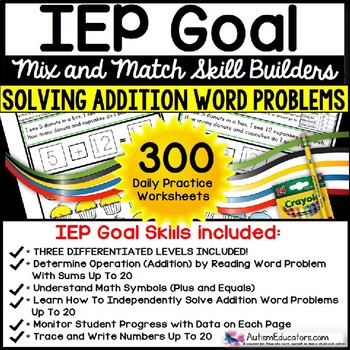
Addition Word Problems - IEP GOAL SKILL BUILDER Worksheets Special Education

SUBTRACTION WORD PROBLEMS - IEP Goal Skill Builder Worksheets Special Education
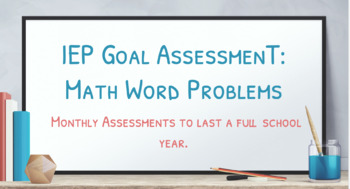
IEP Goal : Math Word Problems Assessment

SUBTRACTION WORD PROBLEMS Worksheets | IEP Goal Review for Special Education
First Grade Math Word Problem Progress Monitoring Assessment - IEP Goal Tracking
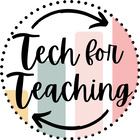
Ready to Use IEP Data Collection- Math Word Problems Goal

2nd Grade - Math Word Problems - Pack of 5 - IEP Goal

1st Grade - Math Word Problems - Pack of 5 - IEP Goal
Assessments for IEP Goal Tracking: Math, Reading and Writing Assessments

180 Daily Math Word Problems Grades 3-4 Spiral Review Bellwork

1 Step Word Problems - IEP data tracking, progress monitoring, Distance Learning

One-Step Addition & Subtraction Word Problems Key Word Part Part Whole 1st Grade

2-Digit 3- & 4-Digit by 1-Digit Multiplication and Word Problems Practice Sheets
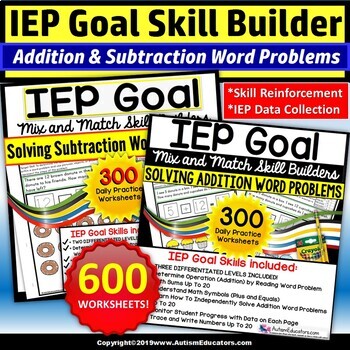
ADDITION and SUBTRACTION Word Problems Worksheet Booklets with Data BUNDLE

Beginning of the Year Math Assessment for Writing Math IEP Goals Volume 1

Word Problem Bundle: Math Assessments, Math Practice, Math Journal

Math One-Step Real-World Word Problems Using Addition/Subtraction (Complete)
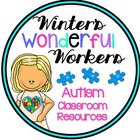
Identifying Coins & Value, Counting Money Worksheets Word Problems 1st 2nd Grade
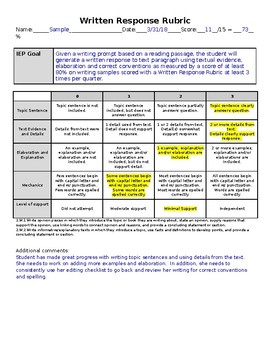
Rubrics for Progress Monitoring IEP Goals
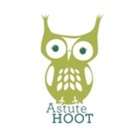
Adding & Subtracting Fractions with Like Denominators Word Problems Mixed Number
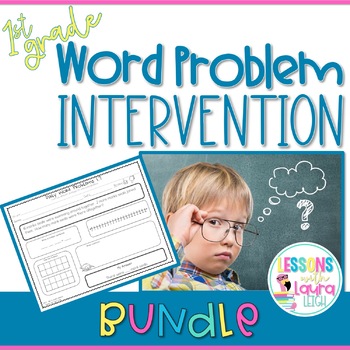
Special Education Math Word Problems Progress Monitoring Intervention BUNDLE

Division Interpreting Remainders Word Problems 2-Digit by 1-Digit 3rd 4th Grade
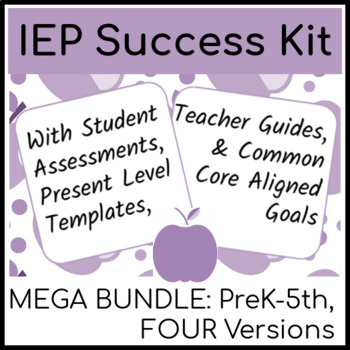
IEP Writing Kit MEGA Bundle with Assessments, PLAAFPs, & IEP Goal Banks

2nd grade Add and Subtract Word Problem Solving Progress Monitoring Assessments

- We're hiring
- Help & FAQ
- Privacy policy
- Student privacy
- Terms of service
- Tell us what you think

IMAGES
COMMENTS
These mathematics goals for students in 2nd to 5th grades focus on building students' abilities to solve real world and story problems. Not seeing the grade level or skill you need? Check out our elementary school, middle school,and high schoolword problem goals.
Here are 10 more examples of Math Word Problem IEP Goals. Objective: Student will accurately identify key information in math word problems. Goal: By the end of the IEP period, student will correctly identify relevant data in 9 out of 10 math word problems. Objective: Student will apply appropriate mathematical operations to solve word problems ...
For special education teachers, IEP goals and lesson plans seem to be the bane of our existence. We are often asked to write goals that are impossible to measure and lack creativity. However, writing IEP goals doesn't have to be so difficult. In fact, it can be quite simple if you know what you're doing.When writing IEP goals for math word problems, you should keep a few things in mind. But ...
Goal: Student will independently solve one and two step multiplication world problems with 100% accuracy on 4 out of 5 trials measured quarterly. Goal: Student will independently read a one or two step word problem, identify which operation is to be used, and solve it with 100% accuracy on 4 out of 5 trials measured quarterly.
Math IEP Goal Bank Students may be working on numeracy or word problems. Whatever their focus, choose a math goal that helps them progress. [STUDENT] will identify a one- or two-digit number (verbally, pointing, written). [STUDENT] will rote-count from 1 to 25 (or higher). [STUDENT] will skip-count by 2, 3, 5, 10 to 50 (verbal or written). When given up to 10 objects, [STUDENT] will count and ...
Browse free CCS-aligned, math goals & objectives for word problems, number sense, computation, geometry, life skills mathematics, and graphing.
4th Grade Math IEP Goal Bank Based On The Common Core Standards. February 3, 2020. Math goals are often tricky to line up with the Common Core Standards (which aren't endorsed by the department of Ed anymore but are still used by almost every curriculum). Meeting a low skill level to an upper grade level can take a lot of thought.
Here's a list of 25 IEP goals for math, covering various aspects including calculation, computation, problem-solving, and mathematical reasoning: Student will accurately add and subtract within (insert range) using appropriate strategies and tools.
Math problem solving is a critical skill for students with learning disabilities that requires individualized support and attention. Effective math problem solving IEP goals are specific, measurable, and achievable, and are developed through collaboration with parents, teachers, and other stakeholders.
Developing problem-solving and reasoning skills allows children to tackle real-world math challenges. IEP math goals here might include solving word problems using addition and subtraction, employing strategies to reason logically, and explaining their thought processes. Strengthening problem-solving abilities helps in interpreting and ...
Goal Example #1: Using a graphic organizer, solve two step addition word problems within numbers 1-100. Student will show mastery by solving these with 70% accuracy across 10 trials this IEP year.
Given a multi-step word problem, student will identify and perform the correct operations (addition, subtraction, multiplication, or division), with %
6th Grade IEP Goals for Word Problems, Computation, and Algebra Yep. This is a hodge-podge! 6th grade Common Core standards are pretty narrow. These are all standards that you can broaden a bit to focus on skills like solving word problems or engaging in computations. All Encoding Sounds Assessment for IEPs and Progress Monitoring Word Problems & Fractions Division Algebra & Computation
Math IEP Goals: Student will be able to use a calculator accurately with 90% accuracy across 10 trials. Student will be able to count to 100 with 100% accuracy across 2 out of 3 trials. Student will be to identify and break down a two digit addition word problem into steps with 70% accuracy across 3 consecutive trials.
The secret lies in individualized education programs (IEPs) and word problem IEP goals specifically designed to empower these students. By setting tailored, achievable goals and implementing effective strategies, we can help special education students unlock their potential and thrive in the world of mathematics.
Problem solving is an essential executive functioning skill. Learn how to integrate it into your functional and academic IEP (and everyday) goals.
A major part of the IEP is the statement of annual IEP goals and objectives. We can think of the goal as being the destination that you want your special education student to get to by the end of a year. The services that you put into place support the goals that have been set a student with a disability.
This IEP GOAL SKILL BUILDER set focuses on solving subtraction word problems from up to 20 (minuend). With TWO different learning levels, students begin at LEVEL 1 with visual support and provides intensive instruction for one-on-one or small group lessons. Having successfully implemented this strategy in my classroom for the past two years, I ...
Browse CCS aligned IEP goals on solving real world and story problems for students in 2nd to 12th grades-- with modification ideas and sample baselines.
This is a math word problems assessment that I use, and it lasts me an entire year of IEP progress monitoring. There are 80 word problems. I use these for goals related to solving word problems, such as just having students identify the operation, or do all of the problem solving process. Goals ca...
This comprehensive guide to IEP goals for autism in kindergarten provides valuable insights into setting the foundation for success at this crucial stage. Elementary school autism IEP objectives: - Improving reading comprehension and writing skills - Enhancing math problem-solving abilities
A math problem solving and procedural (number sense, addition, etc) goal A writing content (narrative, paragraph, etc) and procedural (spelling, fluency, typing) goal
Example of IEP Math Goal:By (date), when given one-step real-world problems using addition and subtraction within 20, (student) will identify the correct operation and then solve the problem (given access to a number line and/or hundreds chart) with 80% accuracy as measured by data twice monthly. Includes:* IEP Goal and 2 objectives* Visual ...
This IEP GOAL SKILL BUILDER set focuses on solving subtraction word problems from up to 20 (minuend). With TWO different learning levels, students begin at LEVEL 1 with visual support and provides intensive instruction for one-on-one or small group lessons. Having successfully implemented this strategy in my classroom for the past two years, I ...